The Long Road to America – One Refugee’s Experience
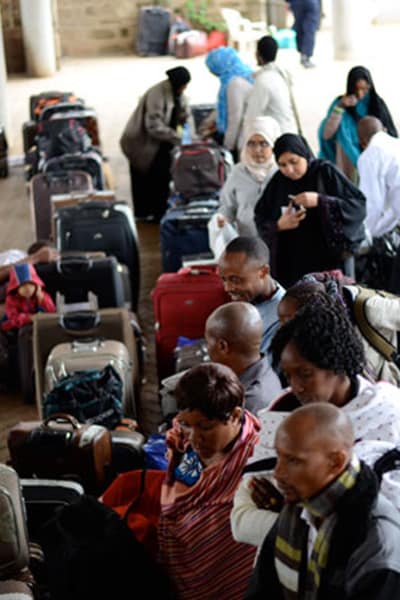
Refugees lining up with their suitcases – all their worldly possessions – as they get ready to board a plane for their new homes in the U.S.
The journey to migrate to the United States can be a long hard road for most refugees and immigrants. Each year, close to 50,000 refugees and 500,000 immigrants come to the United States from around the world to start a new life. CDC’s Division of Global Migration Health (DGMH) makes it a top priority to ensure they are healthy upon arrival to the U.S. DGMH accomplishes this through domestic and overseas programs, and public health interventions such as vaccinations, mandatory health screenings and parasitic treatment programs. By focusing and improving the health of immigrants, U.S. bound refugees, and migrants, DGMH works to keep infectious diseases and other diseases of public health significance from coming into and spreading in the U.S.
DGMH’s Africa Regional Field Program in Kenya primarily works with refugees under consideration for resettlement in the United States. The program collaborates with the UN High Commissioner for Refugees (UNHCR) and other partners to improve the health of refugees. The program also works extensively with the International Organization for Migration (IOM) to oversee the medical screening of U.S.-bound refugees to prevent the spread of communicable diseases, and to ensure the number of panel physicians that can conduct health assessments of resettling refugees is sufficient.
Follow one refugee’s journey to the United States and learn how DGMH works to protect and improve the health of immigrants, U.S. bound refugees, and migrants through domestic and overseas programs.

How Amina’s Journey Began
It is a chilly morning in Nairobi, Kenya, but adults and children alike are bundled up and waiting patiently with their suitcases. They are shuffled through the line to weigh and tag their luggage – all their worldly possessions – as they anxiously await their chance to board a plane and begin a new life in the United States. These families are used to waiting; most fled their homes in the 1990s and have been waiting year after year for the opportunity to resettle and make a permanent home again.
Many refugees can never return to their homeland; they would face continued persecution if they did. Some are also living in perilous situations or have specific needs that cannot be addressed in the country where they have sought protection. In such situations, they are settled in a third country, but the odds of resettlement are long. Of the 10.5 million refugees around the world, less than 1 percent will be relocated.
Amina, one of several members of this 1 percent at the IOM transit center in Nairobi, was pregnant when she started her long, winding, and arduous journey in October 1991 with her husband and 3-year-old son, Mohamed. She came from a village 30 kilometers outside Mogadishu in Somalia. After making their way to Mogadishu, her family traveled by car for 2 days to Kismayo. It took them another 4 days to cover the distance from Kismayo to Liboi, a town on the Kenyan border, on a road that translates to the “Curse of the Parents.” This stretch of road proved to be a curse twice over, as Amina’s infant son died of measles before they reached the border and her husband, returning along this road to reunite his sick mother with the family, was gunned down by a militia group just months before Kenya opened her borders to Somali refugees. Amina’s daughter, Sundes – born a few months later in the Utanga refugee camp on the coast of Kenya – would never know her father.

Amina with her two children Mohamed and Sundes
© CDC-Kenya/Sara Test
Amina moved her children again to another coastal refugee camp, Swaleh Nguru, but in March 1997, the ongoing tension between Kenyan villagers and the Somali refugees escalated. One day, when Amina left her children at the madrassa (a religious school) to go to the market, the locals set fire to the camp. Young Sundes and her older brother smelled smoke and ran 4 kilometers until they found a woman who used to buy goods from their mother and took them in. They were reunited with Amina the same fateful day, but others were not so lucky, as several of their friends were killed in the fires.

Sundes shares her excitement about a new life in America
The United Nations closed Swaleh Nguru and sent Amina and her family to the Kakuma refugee camp in the north of Kenya. When I asked her daughter, Sundes, what it was like to grow up in Kakuma, she shrugged and said, “I can’t complain – it’s life.” She went on to say that it’s stifling hot most of the year and while the refugees are given basic food staples, her mother always worked to buy extra food for the family. Her brother dropped out of school when he reached grade 7 and worked as a tea seller, loader, and waiter so she could attend a private school and get a better education.
Today is the Day: The Journey to the U.S.
Their lives are about to change drastically as they start yet another long journey – this time aboard an airplane en route to Kansas City. Their aspirations are no different from the immigrants who have for centuries sought a better life in the United States. Sundes would like to go to college and, having volunteered with FilmAid International in Kakuma, continue working in film. Mohamed would like to complete high school and work to support his family, while his mother wishes to learn English. Ultimately, however, “living safely is enough for now. Living in Kakuma, you don’t sleep sound at night. Locals come in at night and sometimes rob and shoot refugees. You wonder if someone will die tonight or the next.”
While Sundes is sorry to leave her friends behind, she is buzzing with excitement. This World Refugee Day she will not be performing in any plays in the camp, as she has for the past few years. She will be stepping off a plane, arm-in-arm with her brother and mother, to set down roots in a place where they hope they can finally find peace.
It is important to DGMH that refugees such as Amina, Mohamed, and Sundes have access to medical care and preventive health services prior to arrival in the United States. This family will start their new lives in Kansas City healthy and, most importantly, happy.
- About Refugees
- Improving Health for Kenya's Refugees by Building Laboratory Capacity
- Asia Field Program
To receive email updates about this page, enter your email address:
- Immigrant and Refugee Health
- Importation
- Port Health
- Travelers' Health
- Southern Border Health and Migration
Exit Notification / Disclaimer Policy
- The Centers for Disease Control and Prevention (CDC) cannot attest to the accuracy of a non-federal website.
- Linking to a non-federal website does not constitute an endorsement by CDC or any of its employees of the sponsors or the information and products presented on the website.
- You will be subject to the destination website's privacy policy when you follow the link.
- CDC is not responsible for Section 508 compliance (accessibility) on other federal or private website.

Spartacus Educational
Journey to america.
In the early 19th century sailing ships took about six weeks to cross the Atlantic. With adverse winds or bad weather the journey could take as long as fourteen weeks. When this happened passengers would often run short of provisions. Sometime captains made extra profits by charging immigrants high prices for food needed to survive the trip.
In 1842 the British government attempted to bring an end to the exploitation of passengers by passing legislation that made it the responsibility of the shipping company to provide adequate food and water on the journey. However, the specified seven pounds a week of provisions was not very generous. Food provided by the shipping companies included bread, biscuits and potatoes. This was usually of poor quality. One government official who inspected provisions in Liverpool in 1850 commented that "the bread is mostly condemned bread ground over with a little fresh flour, sugar and saleratus and rebaked."
Captains were sometimes accused of using rations to control the behaviour of their female passengers. William Mure, the British consul in New Orleans reported that one captain "conducted himself harshly and in a most improper manner to some of the female passengers having held out the inducement of better rations to two who were almost starving in the hope they would accede to his infamous designs." In 1860 the New York Commissioners of Emigration reported that there were "frequent complaints made by female emigrants arriving in New York of ill-treatment and abuse from the captains and other officers." As a result of their investigation Congress passed a law that enabled captains and officers to be sent to prison for committing sexual offences against female passengers. However, there is no evidence that anyone was ever prosecuted under this law.
Travellers often complained about the quality of the water on the journey. The main reason for this was that the water was stored in casks that had not been cleaned properly after carrying substances such as oil, vinegar, turpentine or wine on previous journeys. One immigrant travelling in 1815 described the water as having such "a rancid smell that to be in the same neighbourhood was enough to turn one's stomach".
To maximize their profits shipowners tried to cram as many people as possible on board for the trip. In 1848 the U. S. Congress attempted to improve travelling conditions, by passing the American Passenger Act. This legislation prescribed a legal minimum of space for each passenger and one of its consequences was the building of a a new, larger type of ship called the three-decker. The top two decks carried the immigrants and although they had more space, the journey was still unpleasant. It was very dark in the lower deck and their was also a shortage of fresh air. Whereas those on the upper-deck had to contend with the stench rising constantly from below.
Immigrants suffered many dangers when crossing the Atlantic. This included fires and shipwrecks . In August, 1848, the Ocean Monarch , carrying immigrants from Liverpool to Boston , caught fire and 176 lives were lost. As ships got larger so did the deaths from fires. In September, 1858, an estimated 500 immigrants died after a fire on the steamship Austria . Another 400 died on the William Nelson in July, 1865.
In 1834 seventeen ships shipwrecked in the Gulf of St Lawrence and 731 emigrants lost their lives. In a five year period (1847-52) 43 emigrant ships out of 6,877 failed to reach their destination, resulting in the deaths of 1,043 passengers. In 1854 the steamship City of Glasgow carrying 480 emigrants went missing after leaving Liverpool and was never heard of again.
A major problem for emigrants on board ship was disease . There were serious outbreaks of cholera in 1832, 1848 and 1853. Of the 77 vessels which left Liverpool for New York between 1st August and 31st October, 1853, 46 contained passengers that died of cholera on the journey. The Washington suffered 100 deaths and the Winchester lost 79. All told, 1,328 emigrants died on board these ships on the way to America.
The most common killer was typhus . It was particularly bad when the passengers had been weakened by a poor diet. In 1847, during the Irish Famine, 7,000 people, most of them from Ireland , died of typhus on the way to America. Another 10,000 died soon after arriving in quarantine areas in the United States.
In 1852 shipping companies began using steamships to transport immigrants to America. This included the ships the City of Manchester and the City of Glasgow, that could transport 450 immigrants at a time from Liverpool to New York. The fare of six guineas a head was double that charged by sailing ships. However, it was much faster and by the 1870s the journey across the Atlantic was only taking two weeks.
Primary Sources
(1) reverend william bell, writing about the quality of the water on a boat sailing from leith to quebec in 1817..
Our water has for some time past been very bad. When it was drawn out of the casks it was no cleaner than that of a dirty kennel after a shower of rain, so that its appearance alone was sufficient to sicken one. Buts its dirty appearance was not its worst quality. It had such a rancid smell that to be in the same neighbourhood was enough to turn one's stomach.
(2) In 1860 the New York Commissioners of Emigration carried out an investigation into the treatment of female passengers on board ship bring immigrants from Europe to the United States.
The frequent complaints made by female emigrants arriving in New York of ill-treatment and abuse from the captains and other officers. caused us to investigate the subject; and from investigation we regret to say that after reaching the high seas the captain frequently selects some unprotected female from among the passengers, induces her to visit his cabin, and when there, abusing his authority as commander, partly by threats, and partly by promises of marriage, accomplishes her ruin, and retains her in his quarters for the rest of the voyage, for the indulgence of his vicious passions and the purposes of prostitution; other officers of the ship often imitate the example of their superior, and when the poor friendless woman, this seduced, arrive at this port, they are thrust upon shore and abandoned to their fate.
(3) Samuel Gompers and his family emigrated to the United States in the summer of 1863.
The Cigarmakers' Society Union of England, whose members were frequently unemployed and suffering, established an emigration fund - that is, instead of paying the members unemployment benefits, a sum of money was granted to help passage from England to the United States. The sum was not large, between five and ten pounds. This was a very practical method which benefited both the emigrants and those who remained by decreasing the number seeking work in their trade. After much discussion and consultation father decided to go to the New World. He had friends in New York City and a brother-in-law who proceeded us by six months to whom father wrote we were coming. There came busy days in which my mother gathered together and packed our household belongings. Father secured passage on the City of London, a sailing vessel which left Chadwick Basin, June 10, 1863, and reached Castle Garden, July 29, 1863, after seven weeks and one day. Our ship was the old type of sailing vessel. We had none of the modern comforts of travel. The sleeping quarters were cramped and we had to had to do our own cooking in the gallery of the boat. Mother had provided salt beef and other preserved meats and fish, dried vegetables, and red pickled cabbage which I remember most vividly. We were all seasick except father, mother the longest of all. Father had to do all the cooking in the meanwhile and take care of the sick. There was a Negro man employed on the boat who was very kind in many ways to help father. Father did not know much about cooking. When we reached New York we landed at the old Castle Garden of lower Manhattan, now the Aquarium, where we were met by relatives and friends. As we were standing in a little group, the Negro who had befriended father on the trip, came off the boat. Father was grateful and as a matter of courtesy, shook hands with him and gave him his blessing. Now it happened that the draft and negro rights were convulsing New York City. Only that very day Negroes had been chased and hanged by mobs. The onlookers, not understanding, grew very much excited over father's shaking hands with this Negro. A crowd gathered round and threatened to hang both father and the Negro to the lamp-post.
Student Activities
The Middle Ages
The Normans
The English Civil War
Industrial Revolution
First World War
Russian Revolution
Nazi Germany

‘This Is For My Son’s Life, My Wife’s Life.’ The Migration Journey to the U.S. Continues Despite Complicated Border Policy
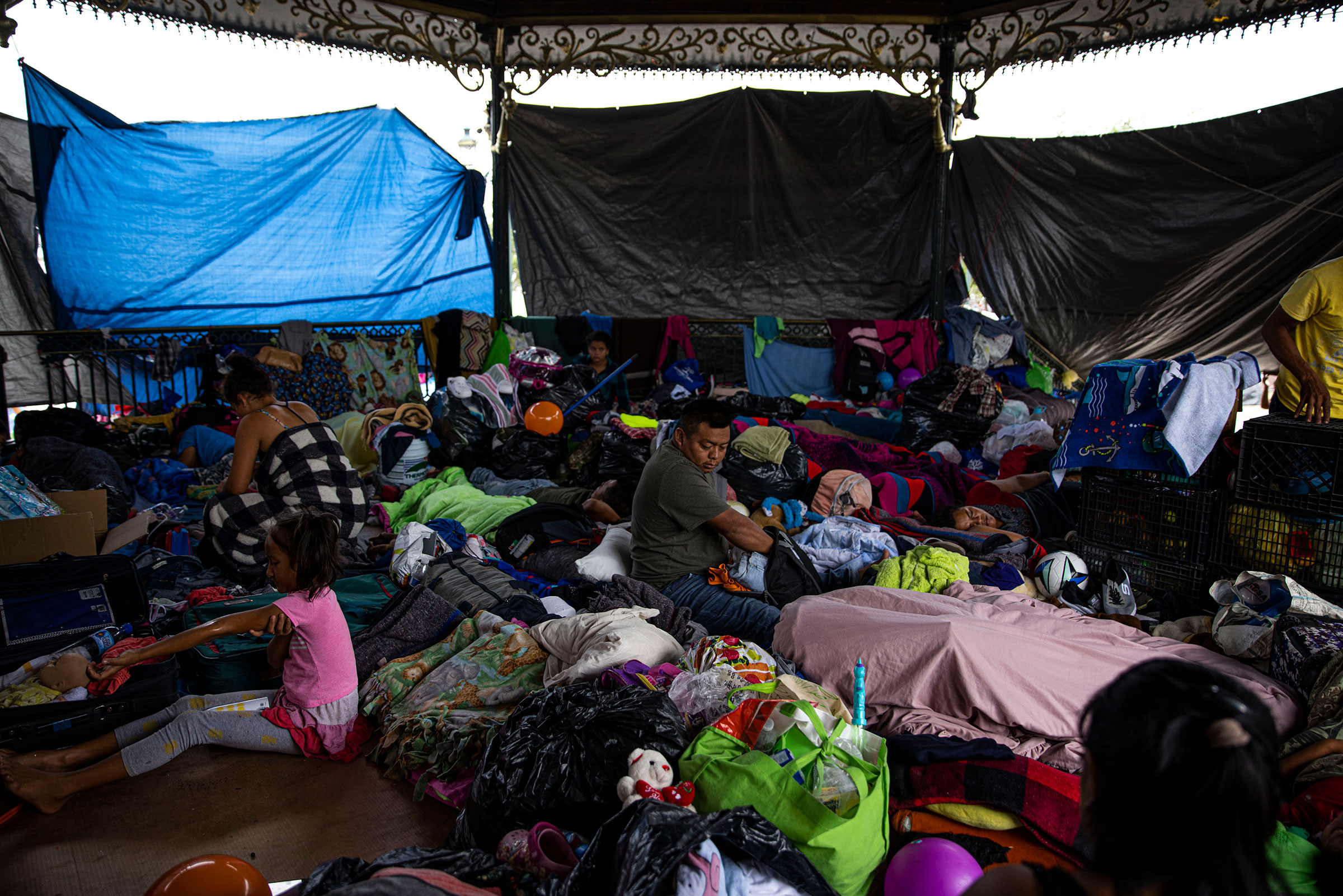
J ose Mirabal first tried to come from Honduras to the U.S. 15 years ago, but didn’t make it. Like many before and since he boarded La Bestia or “The Beast”—an infamously dangerous network of cargo trains that wends north across Mexico . In 2006, Mirabal fell from the train and had to have his foot amputated. He returned to Honduras with a prosthetic.
But 2020 was a hard year. COVID-19 strained businesses and health care systems in Honduras, and in November two hurricanes struck the country, leaving thousands of people homeless. So in 2021, Mirabel decided to try his chances again—once again traveling to Mexico and boarding La Bestia . He’s 40 now, and the journey is harder on his body. He doesn’t dare take off his prosthetic because he doesn’t want to risk it getting stolen, he says, and if he needed to run away quickly, he wouldn’t have time to put it back on.
“Not all of us run with the same luck,” Mirabal says, speaking in Spanish from Coatzacoalcos, a city in Mexican state of Veracruz. He’s traveling with his cousin. “Some of us run with good luck, and others unfortunately run with the bad luck. My cousin and I, thank God, have been moving day and night…and so far nothing bad has happened to us.”
Freelance photographer Yael Martínez documented Mirabal and several other migrants’ journeys from Honduras, through Mexico to the U.S.-Mexico border this year. He photographed them crossing the Mexican state of Veracruz and ending in Reynosa and Matamoros, Mexican cities across the border from McAllen and Brownsville, Texas, respectively.

People, like Mirabel, from Central America and Mexico have been attempting to come to the U.S. for decades, but this year marks an inflection point. U.S. Customs and Border Protection (CBP) conducted more than 1.7 million enforcement actions at the U.S.-Mexico border during Fiscal Year 2021, which ended on Sept. 30, according to CBP data . These enforcement actions include arrests and expulsions under Title 42 , a Trump-era health measure that the Biden Administration has kept in place and has used to immediately remove individuals because of the risks posed by COVID-19 without granting them access to the asylum system.
Title 42 expulsions accounted for more than one million of the 1.7 million enforcement actions during FY2021, meaning most of the migrants who have arrived at the U.S.-Mexico border have been immediately denied entry to the U.S. FY2021 also set the record for most border enforcement encounters by U.S. Border Patrol Agents, according to CBP data . Border Patrol conducted nearly 1.66 million enforcement actions in FY21, surpassing the previous record high of nearly 1.62 million in 1986.
Read More: Biden Is Expelling Migrants On COVID-19 Grounds, But Health Experts Say That’s All Wrong
The U.S. saw an uptick in migration from Central America beginning in the 1980s brought on by regional civil wars (which the U.S. had involvement in), economic instability and displacement, according to the Migration Policy Institute (MPI), a nonpartisan research institution. That migration flow never ended, particularly from the Northern Triangle countries, El Salvador, Guatemala and Honduras. From 2007 to 2017, the number of unauthorized migrants from Central America began increasing from previous levels seen in the ’80s, according to the Pew Research Center , while the number of unauthorized migrants from Mexico declined. By Fiscal Year 2014, the number of Central American migrants surpassed those from Mexico for the first time in history.
Still, migration to the U.S.-Mexico border is constantly evolving . In recent years, more Central American migrants have sought out humanitarian protection in the U.S. and are not attempting to evade detection by border enforcement officials, according to MPI.
Read more: More Migrants Die Crossing the Border in South Texas Than Anywhere Else in the U.S. This Documentary Depicts the Human Toll
Then came the Trump Administration’s hardline immigration and border policies such as Zero Tolerance and family separation , metering, the Migrant Protection Protocols (MPP) and Title 42, the ramifications of which the Biden Administration is still facing today. The Biden Administration is now in negotiations with the Mexican government to reinstate MPP to comply with a federal court order.
Since 2019, these policies have led to overcrowded shelters in dangerous Mexican border cities and towns, and many thousands of migrants have lived in makeshift tent encampments in Tijuana, Reynosa and Matamoros.
“There are millions of us migrants,” Mirabal says. “Women with children, with their children on foot, children at their breast. The people are coming who are suffering just trying to find a better life.”

In Honduras, the damage to homes and businesses from hurricanes Eta and Iota in November 2020, plus the impacts of COVID-19 have left an estimated 2.8 million people in need of humanitarian assistance, according to the United Nations Office for the Coordination of Humanitarian Affairs (OCHA). Even before the hurricanes struck, the number of family units from Honduras who were apprehended at the U.S.-Mexico border rose from 513 to 188,368 between 2012 and 2019, according to analysts at the Brookings Institute , a nonprofit research and policy organization. Brookings analysts also predict that the hurricanes caused an increase in migration from Honduras. In 2021, the number of Honduran family units encountered at the border rose from 1,968 in January, to nearly 25,000 in March, according to an analysis of CBP data .
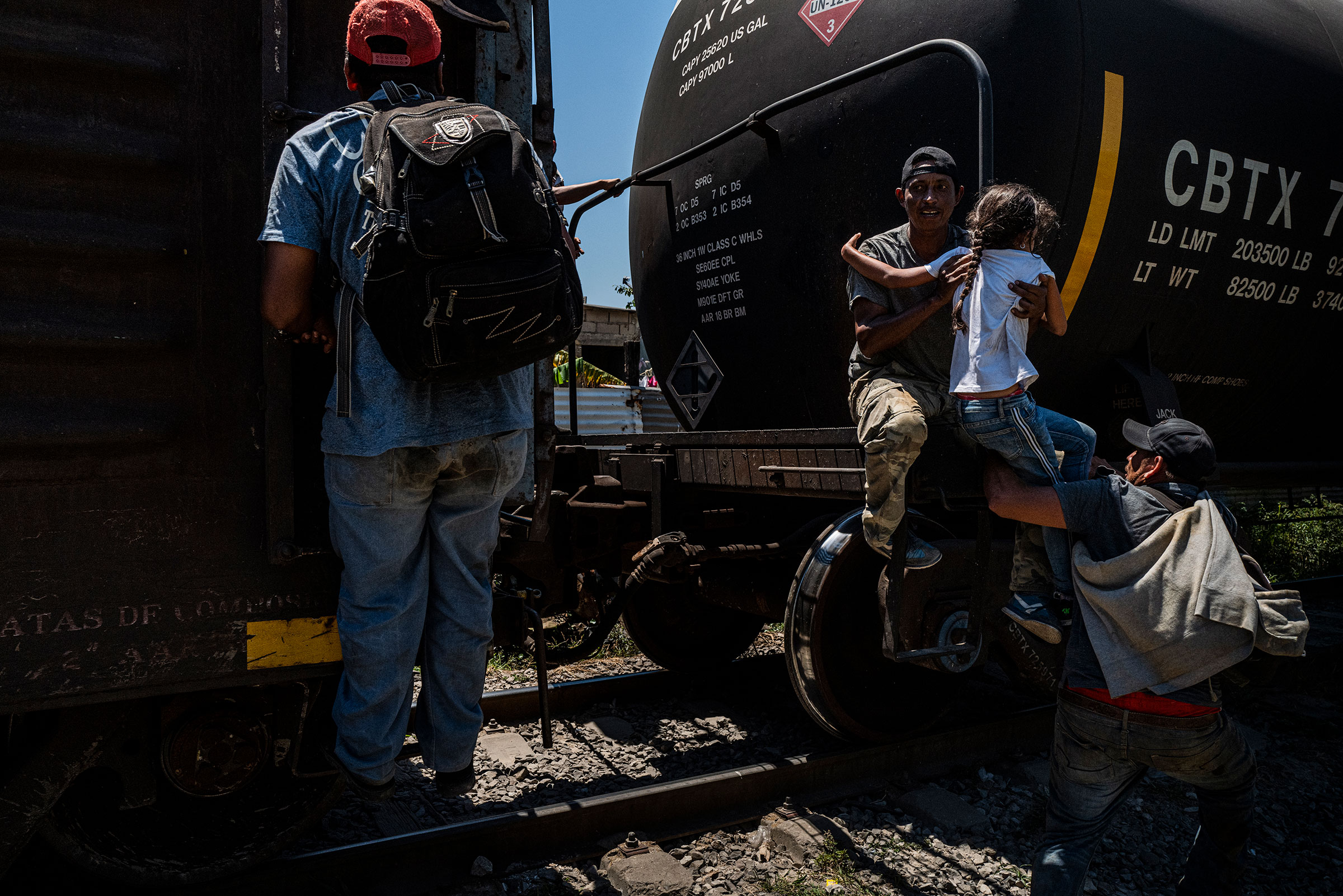
La Bestia isn’t the only danger migrants encounter in Mexico. Whether migrants are traveling by train or other modes of transport, they are often targeted by members of organized crime groups who extort, kidnap them for ransom or rob them. Sexual assault is frequent. And at any point, migrants could be found by Mexican officials and deported. At the behest of the Trump Administration, the Mexican government began cracking down on migrants at its own Southern border. Though the Mexican government has in the past cooperated with previous administrations to try to stop migrants from crossing its southern border with Guatemala, Trump stepped up the pressure by threatening to impose tariffs and shut down the U.S.-Mexico border.
For those who do make it to the U.S.-Mexico border, the risks do not end there. Migrants have been the victims of a massacre along the border, allegedly by Mexican police. Human Rights First, a nonprofit advocacy and research organization, has tracked more than 6,000 reports of violence against migrants stuck in Mexico during the first few months of the Biden Administration alone.
“I’m not safe in my country nor in Mexico as a refugee,” says Carlos Roberto Tunez, a migrant from Honduras. He and his family fled Honduras in 2019 after they were threatened by gangs. The family first became official refugees in Mexico and were content with starting a new life there, he said. They opened a new business selling Honduran food. But after just a few months, members of an organized crime group began extorting them. When Tunez reported the extortion to Mexican officials, the organized crime group found out, and Tunez and his family found themselves on the run again, this time hoping to seek refuge in the U.S. At the time of his interview, Tunez and his family had been sleeping under a bridge in Reynosa for 10 days.

For Tunez’s wife, Cyndy Cacares, it’s difficult to recount the journey. On May 4, Martínez showed Cacares a portrait he took of her and her son. It immediately brought her to tears. “My dream is to give my son a better life, and try to keep going” she said. “I can’t, I just can’t [talk] anymore.”
“It’s really hard for her to talk about this,” Tunez says. “We’ve suffered a lot on the journey here. It’s hard, and it also makes me want to cry having to recount the story… If myself from years ago saw myself now, he’d see someone very different. I’m here full of fear, full of terror more than anything because this is for my son’s life, my wife’s life.”
Make sense of what matters in Washington. Sign up for the daily D.C. Brief newsletter.
More Must-Reads From TIME
- The 100 Most Influential People of 2024
- How Far Trump Would Go
- Scenes From Pro-Palestinian Encampments Across U.S. Universities
- Saving Seconds Is Better Than Hours
- Why Your Breakfast Should Start with a Vegetable
- 6 Compliments That Land Every Time
- Welcome to the Golden Age of Ryan Gosling
- Want Weekly Recs on What to Watch, Read, and More? Sign Up for Worth Your Time
Write to PHOTOGRAPHS BY Yael Martínez FOR TIME at [email protected]

Journey to America: What's Your Story?
Posted by Dan Sigward on March 23, 2017
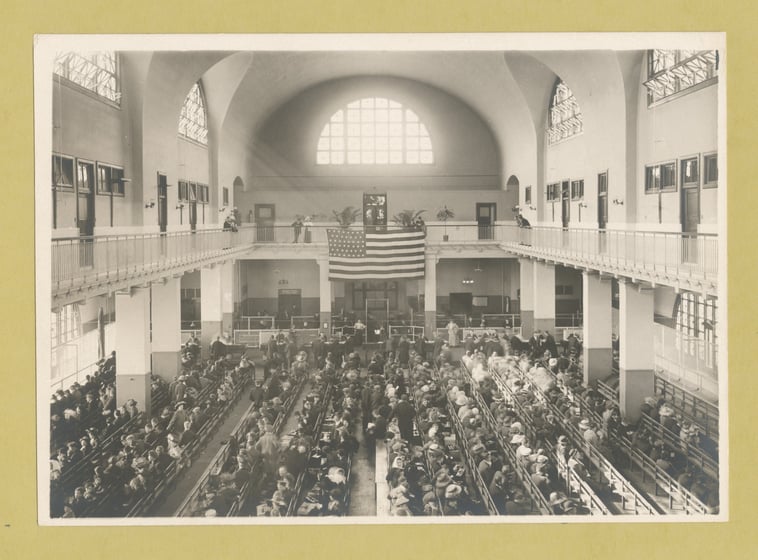
Every family in the United States originated from somewhere else. From Native Americans who migrated across a land bridge to North America to immigrants who sailed aboard a steamship to Ellis Island, many chose to come to America. Hundreds of thousands of others were brought here against their will aboard slave ships.
Throughout this history, we have debated who should be allowed to come to live here and who may not. Laws and policies regarding immigration and refugee resettlement are important to debate in any country but just as important is the language and rhetoric we use in these debates. Too often, today’s rhetoric reflects a poor understanding of the history of immigration laws, creating distance between our own families’ narratives and the stories of those coming to America today.
Reflecting on my own family history made me consider an important question: How might better understanding the historical context of our own ancestors’ immigration stories affect how we think about the immigration debate today?
My ancestors emigrated from Alsace-Lorraine (a disputed territory between France and Germany) and Ireland within the second half of the 1800s. The reasons that likely motivated them are not much different than those of newcomers who are at the center of today’s debate. German and Irish Catholics were among the largest immigrant groups in the United States in the latter half of the 19th century. Irish immigrants fled famine, poverty, and lack of employment opportunity. Germans fled similar circumstances in addition to social and political unrest in the aftermath of wars. Today’s immigrants and refugees aren’t nameless, faceless hordes, but human beings seeking safety and prosperity just like my ancestors.
Though I don’t know much about my ancestors’ specific circumstances,, there is one detail I’m certain of: they neither broke nor circumvented any immigration laws by entering the United States, because there were no such laws. It is not that German and Irish immigrants were universally welcomed to the United States; they were subject to plenty of anti-Irish and anti-Catholic sentiments. But there were no laws preventing them or anyone else from coming to the United States at the time.
For me to claim that my 19th century ancestors were “legal” immigrants in contrast to today’s “illegal,” undocumented immigrants implies that my ancestors made a moral or ethical choice to “wait in line, follow the law, and play by the rules.” That claim puts distance between “us” and “them” by attempting to distinguish my “morally superior” ancestors from today’s “law-breaking” undocumented immigrants.
The first significant immigration law was the 1882 Chinese Exclusion Act, which banned nearly all Chinese immigrants from entering the country. Laws further restricting immigration were enacted in the 1920s in response to the influx of Italians, Eastern Europeans, and Jews in the early 20th century. Soon they began enforcing strict quotas based on national origin, which lasted until 1965. New laws replaced these quotas with preferences based on family relationships, skills, and other factors.
It is impossible for me to know what my ancestors would have chosen to do if faced with restrictions like these designed to keep them out of the United States. Was their desire for safety and opportunity, their longing to live in the United States, so great that they would have sought a way around laws in place to keep them out? Lucky for them, they didn’t have to choose.
This is, perhaps, a question of “ moral luck ,” a topic we explore in the newly revised edition of Holocaust and Human Behavior . Our choices are often constrained by the ways we perceive the options available to us in any particular time, place, and circumstance. Can we praise someone in the past for being virtuously law-abiding when there were no laws conflicting with their goals and no dilemma requiring a moral choice?
My goal is not to minimize the hardships and sacrifices our ancestors endured. To leave behind their home in search of safety, security, and opportunity was no easy endeavor. Whatever policies we decide to implement as a country or society today, we ought to strive to avoid the cruelty that often can result when we think of immigrants as threatening, criminal, or dangerous. Instead, by reflecting on our own stories about how we came to America, we might inject the debate with knowledge, insight, and humility that can help us steer clear of dangerous “us" vs. "them” thinking. This is what I learned from my story. What can you learn from yours? What can your students learn from theirs?
Want to explore the idea of “moral luck” with your students? Check out the reading, “ Moral Luck and Dilemmas of Judgment ,” from our newly revised edition of Holocaust and Human Behavior.

Photo Credit and Caption: The Miriam and Ira D. Wallach Division of Art, Prints and Photographs: Photography Collection, The New York Public Library. "Immigrants seated on long benches, Main Hall, U.S. Immigration Station." New York Public Library Digital Collections. Accessed March 13, 2017. http://digitalcollections.nypl.org/items/510d47da-d8d7-a3d9-e040-e00a18064a99
Topics: Immigration , Holocaust and Human Behavior , current events , We and They

Written by Dan Sigward
Subscribe to Email Updates
Recent posts, posts by topic.
- Choosing to Participate (70)
- Facing Technology (69)
- History (67)
- Democracy (62)
- Black History (58)
- Teaching Resources (57)
- Holocaust (54)
- Facing History and Ourselves (52)
- American History (51)
- Facing History Resources (48)
- Identity (48)
- Antisemitism (45)
- Classrooms (45)
- Teaching (45)
- Media Skills (42)
- Teachers (42)
- current events (37)
- Holocaust and Human Behavior (36)
- Online Learning (36)
- Professional Development (35)
- Holocaust Education (33)
- Civil Rights (32)
- Genocide/Collective Violence (32)
- Safe Schools (32)
- Racism (31)
- Human Rights (30)
- To Kill a Mockingbird (30)
- Civil Rights Movement (28)
- Race and Membership (28)
- Student Voices (28)
- Immigration (27)
- Students (27)
- Reading List (26)
- Teaching Strategies (26)
- Upstanders (25)
- Critical Thinking (24)
- Listenwise (24)
- Reconstruction (23)
- Women's History Month (23)
- Facing History Together (22)
- Memory (22)
- School Culture (22)
- Schools (22)
- Survivor Testimony (22)
- EdTech (20)
- Today's News Tomorrow's History (20)
- International (19)
- Armenian Genocide (18)
- Universe of Obligation (18)
- Asian American and Pacific Islander History (17)
- English Language Arts (17)
- Social Media (17)
- genocide (17)
- Flipped Classroom (16)
- Innovative Classrooms (16)
- Native Americans (16)
- Holocaust and Human Behaviour (15)
- Margot Stern Strom Innovation Grants (15)
- Back-To-School (14)
- New York (14)
- civil discourse (14)
- Contests (13)
- Human Behavior (13)
- Empathy (12)
- Bullying (11)
- Neighborhood to Neighborhood (11)
- Community (10)
- Equity in Education (10)
- Events (10)
- Indigenous (10)
- Journalism (10)
- Stereotype (10)
- Voting Rights (10)
- global terrorism (10)
- Community Conversations (9)
- Refugees (9)
- United Kingdom (9)
- difficult conversations (9)
- Bullying and Ostracism (8)
- In the news (8)
- Online Tools (8)
- Reading (8)
- Religious Tolerance (8)
- Webinars (8)
- Common Core State Standards (7)
- Diversity (7)
- Latinx History (7)
- Memorials (7)
- Refugee Crisis (7)
- South Africa (7)
- Upstander (7)
- Webinar (7)
- Writing (7)
- Facing Ferguson (6)
- Jewish Educational Partisan Foundation (6)
- Judgement and Legacy (6)
- Memphis (6)
- Readings (6)
- Social-Emotional Learning (6)
- The Nanjing Atrocities (6)
- Decision-making (5)
- Harper Lee (5)
- Jewish Education Program (5)
- Literature (5)
- Museum Studies (5)
- Public Radio (5)
- Raising Ethical Children (5)
- Sounds of Change (5)
- StoryCorps (5)
- reflection (5)
- Assessment (4)
- Bryan Stevenson (4)
- Common Core (4)
- Cyberbullying (4)
- Learning (4)
- Lesson Plans (4)
- Social Justice (4)
- Social and Emotional Learning (4)
- Teaching Strategy (4)
- We and They (4)
- international holocaust remembrance day (4)
- Beacon Academy (3)
- Benjamin B. Ferencz (3)
- Cleveland (3)
- Eugenics/Race Science (3)
- Experiential education (3)
- IWitness (3)
- Indigenous History (3)
- Japanese American Incarceration (3)
- Photography (3)
- Restorative Justice (3)
- Roger Brooks (3)
- Salvaged Pages (3)
- The BULLY Project (3)
- The Great Listen (3)
- Twitter (3)
- media literacy (3)
- news literacy (3)
- student activism (3)
- transgender (3)
- white supremacy (3)
- workshop (3)
- Black History Month (2)
- Brussels (2)
- Bystander (2)
- Chicago (2)
- Civil War (2)
- David Isay (2)
- Day of Learning (2)
- Digital Divide (2)
- Essay Contest (2)
- Facing History Library (2)
- Giving Tuesday (2)
- Go Set a Watchman (2)
- International Justice (2)
- Lesson Plan (2)
- Los Angeles (2)
- Lynsey Addario (2)
- Margaret Stohl (2)
- New York Times (2)
- Northern Ireland (2)
- Online Workshop (2)
- Parents (2)
- Partisans (2)
- San Francisco Bay Area (2)
- September 11 (2)
- Shikaya (2)
- Slavery (2)
- Sonia Nazario (2)
- Spoken Word (2)
- The Allstate Foundation (2)
- Toronto (2)
- Weimar Republic (2)
- Zaption (2)
- civic education (2)
- climate change (2)
- environmental justice (2)
- islamophobia (2)
- primary sources (2)
- resistance (2)
- Auschwitz (1)
- Black Teachers (1)
- Brave Space (1)
- Cambodia (1)
- Canadian History (1)
- Caregivers (1)
- Colombia (1)
- Deborah Prothrow-Stith (1)
- Desegregation (1)
- Don Cheadle (1)
- Douglas Blackmon (1)
- Explorations (1)
- Farewell to Manzanar (1)
- Haitian Revolution (1)
- Hurricane Katrina (1)
- Indigenous Peoples' Day (1)
- Insider (1)
- International Women's Day (1)
- Isabel Wilkerson (1)
- Latin America (1)
- Lesson Ideas (1)
- Literacy Design Collaborative (1)
- Marc Skvirsky (1)
- Margot Stern Strom (1)
- Memorial (1)
- Mental Health Awareness (1)
- Race and Membership in American History: Eugenics (1)
- Reach Higher Initiative (1)
- Rebuke to Bigotry (1)
- Red Scarf Girl (1)
- Religion (1)
- Residential Schools (1)
- Socratic Seminar (1)
- Summer Seminar (1)
- Truth and Reconciliation (1)
- Urban Education (1)
- Using Technology (1)
- Vichy Regime (1)
- Wes Moore (1)
- Whole School Work (1)
- anti-Muslim (1)
- archives (1)
- coming-of-age literature (1)
- cross curricular teaching and learning (1)
- differentiated instruction (1)
- facing history pedagogy (1)
- literacy (1)
- little rock 9 (1)
- new website (1)
- xenophobia (1)
Pilgrims’ Progress
We retrace the travels of the ragtag group that founded Plymouth Colony and gave us Thanksgiving
Simon Worrall
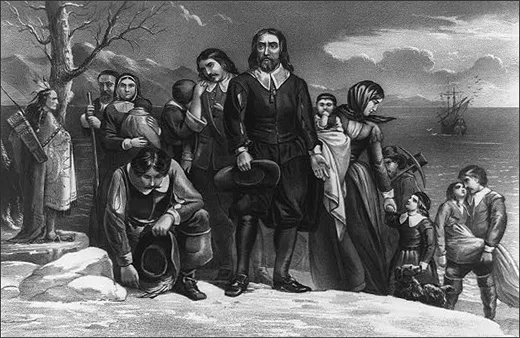
On an autumn night in 1607, a furtive group of men, women and children set off in a relay of small boats from the English village of Scrooby, in pursuit of the immigrant's oldest dream, a fresh start in another country. These refugees, who would number no more than 50 or 60, we know today as Pilgrims. In their day, they were called Separatists. Whatever the label, they must have felt a mixture of fear and hope as they approached the dimly lit creek, near the Lincolnshire port of Boston, where they would steal aboard a ship, turn their backs on a tumultuous period of the Reformation in England and head across the North Sea to the Netherlands.
There, at least, they would have a chance to build new lives, to worship as they chose and to avoid the fate of fellow Separatists like John Penry, Henry Barrow and John Greenwood, who had been hanged for their religious beliefs in 1593. Like the band of travelers fleeing that night, religious nonconformists were seen as a threat to the Church of England and its supreme ruler, King James I. James' cousin, Queen Elizabeth I (1533-1603), had made concerted efforts to reform the church after Henry VIII's break with the Roman Catholic faith in the 1530s. But as the 17th century got under way at the end of her long reign, many still believed that the new church had done too little to distinguish itself from the old one in Rome.
In the view of these reformers, the Church of England needed to simplify its rituals, which still closely resembled Catholic practices, reduce the influence of the clerical hierarchy and bring the church's doctrines into closer alignment with New Testament principles. There was also a problem, some of them felt, with having the king as the head of both church and state, an unhealthy concentration of temporal and ecclesiastical power.
These Church of England reformers came to be known as Puritans, for their insistence on further purification of established doctrine and ceremony. More radical were the Separatists, those who split off from the mother church to form independent congregations, from whose ranks would come the Baptists, Presbyterians, Congregationalists and other Protestant denominations. The first wave of Separatist pioneers—that little band of believers sneaking away from England in 1607—would eventually be known as Pilgrims. The label, which came into use in the late 18th century, appears in William Bradford's Of Plymouth Plantation .
They were led by a group of radical pastors who, challenging the authority of the Church of England, established a network of secret religious congregations in the countryside around Scrooby. Two of their members, William Brewster and William Bradford, would go on to exert a profound influence on American history as leaders of the colony at Plymouth, Massachusetts, the first permanent European settlement in New England and the first to embrace rule by majority vote.
For the moment, though, they were fugitives, inner exiles in a country that did not want their brand of Protestantism. If caught, they faced harassment, heavy fines and imprisonment.
Beyond a few tantalizing details about the leaders Brewster and Bradford, we know very little about these English men and women who formed the vanguard of the Pilgrim's arrival in the New World—not even what they looked like. Only one, Edward Winslow, who became the third governor of Plymouth Colony in 1633, ever sat for his portrait, in 1651. We do know that they did not dress in black and white and wear stovepipe hats as the Puritans did. They dressed in earth tones—the green, brown and russet corduroy typical of the English countryside. And, while they were certainly religious, they could also be spiteful, vindictive and petty—as well as honest, upright and courageous, all part of the DNA they would bequeath to their adopted homeland.
To find out more about these pioneering Englishmen, I set off from my home in Herefordshire and headed north to Scrooby, now a nondescript hamlet set in a bucolic landscape of red brick farmhouses and gently sloping fields. The roadsides were choked with daffodils. Tractors chugged through rich fields with their wagons full of seed potatoes. Unlike later waves of immigrants to the United States, the Pilgrims came from a prosperous country, not as refugees escaping rural poverty.
The English do not make much of their Pilgrim heritage. "It's not our story," a former museum curator, Malcolm Dolby, told me. "These aren't our heroes." Nonetheless, Scrooby has made at least one concession to its departed predecessors: the Pilgrim Fathers pub, a low, whitewashed building, right by the main road. The bar used to be called the Saracen's Head but got a face-lift and a change of name in 1969 to accommodate American tourists searching their roots. A few yards from the pub, I found St. Wilfrid's church, where William Brewster, who would become the spiritual leader of Plymouth Colony, once worshiped. The church's current vicar, the Rev. Richard Spray, showed me around. Like many medieval country churches, St. Wilfrid's had a makeover in the Victorian era, but the structure of the building Brewster knew remained largely intact. "The church is famous for what's not in it," Spray said. "Namely, the Brewsters and the other Pilgrims. But it's interesting to think that the Thanksgiving meal they had when they got to America apparently resembled a Nottinghamshire Harvest Supper—minus the turkey!"
A few hundred yards from St. Wilfrid's, I found the remains of Scrooby Manor, where William Brewster was born in 1566 or 1567. This esteemed Pilgrim father gets little recognition in his homeland—all that greets a visitor is a rusting "No Trespassing" sign and a jumble of half-derelict barns, quite the contrast to his presence in Washington, D.C. There, in the Capitol, Brewster is commemorated with a fresco that shows him—or, rather, an artist's impression of him—seated, with shoulder-length hair and a voluminous beard, his eyes raised piously toward two chubby cherubs sporting above his head.
Today, this rural part of eastern England in the county of Nottinghamshire is a world away from the commerce and bustle of London. But in William Brewster's day, it was rich in agriculture and maintained maritime links to northern Europe. Through the region ran the Great North Road from London to Scotland. The Brewster family was well respected here until William Brewster became embroiled in the biggest political controversy of their day, when Queen Elizabeth decided to have her cousin, Mary, Queen of Scots, executed in 1587. Mary, a Catholic whose first husband had been the King of France, was implicated in conspiracies against Elizabeth's continued Protestant rule.
Brewster's mentor, the secretary of state, became a scapegoat in the aftermath of Mary's beheading. Brewster himself survived the crisis, but he was driven from the glittering court in London, his dreams of worldly success dashed. His disillusionment with the politics of court and church may have led him in a radical direction—he fatefully joined the congregation of All Saints Church in Babworth, a few miles down the road from Scrooby.
There the small band of worshipers likely heard the minister, Richard Clyfton, extolling St. Paul's advice, from Second Corinthians, 6:17, to cast off the wicked ways of the world: "Therefore come out from them, and be separate from them, says the Lord, and touch nothing unclean." (This bit of scripture probably gave the Separatists their name.) Separatists wanted a better way, a more direct religious experience, with no intermediaries between them and God as revealed in the Bible. They disdained bishops and archbishops for their worldliness and corruption and wanted to replace them with a democratic structure led by lay and clerical elders and teachers of their own choosing. They opposed any vestige of Catholic ritual, from the sign of the cross to priests decked out in vestments. They even regarded the exchanging of wedding rings as a profane practice.
A young orphan, William Bradford, was also drawn into the Separatist orbit during the country's religious turmoil. Bradford, who in later life would become the second governor of Plymouth Colony, met William Brewster around 1602-3, when Brewster was about 37 and Bradford 12 or 13. The older man became the orphan's mentor, tutoring him in Latin, Greek and religion. Together they would travel the seven miles from Scrooby to Babworth to hear Richard Clyfton preach his seditious ideas—how everyone, not just priests, had a right to discuss and interpret the Bible; how parishioners should take an active part in services; how anyone could depart from the official Book of Common Prayer and speak directly to God.
In calmer times, these assaults on convention might have passed with little notice. But these were edgy days in England. James I (James VI as King of Scotland) had ascended to the throne in 1603. Two years later, decades of Catholic maneuvering and subversion had culminated in the Gunpowder Plot, when mercenary Guy Fawkes and a group of Catholic conspirators came very close to blowing up Parliament and with them the Protestant king.
Against this turmoil, the Separatists were eyed with suspicion and more. Anything smacking of subversion, whether Catholic or Protestant, provoked the ire of the state. "No bishop, no king!" thundered the newly crowned king, making it clear that any challenge to church hierarchy was also a challenge to the Crown and, by implication, the entire social order. "I shall make them conform," James proclaimed against the dissidents, "or I will hurry them out of the land or do worse."
He meant it. In 1604, the Church introduced 141 canons that enforced a sort of spiritual test aimed at flushing out nonconformists. Among other things, the canons declared that anyone rejecting the practices of the established church excommunicated themselves and that all clergymen had to accept and publicly acknowledge the royal supremacy and the authority of the Prayer Book. It also reaffirmed the use of church vestments and the sign of the cross in baptism. Ninety clergymen who refused to embrace the new canons were expelled from the Church of England. Among them was Richard Clyfton, of All Saints at Babworth.
Brewster and his fellow Separatists now knew how dangerous it had become to worship in public; from then on, they would hold only secret services in private houses, such as Brewster's residence, Scrooby Manor. His connections helped to prevent his immediate arrest. Brewster and other future Pilgrims would also meet quietly with a second congregation of Separatists on Sundays in Old Hall, a timbered black-and-white structure in Gainsborough. Here under hand-hewn rafters, they would listen to a Separatist preacher, John Smyth, who, like Richard Clyfton before him, argued that congregations should be allowed to pick and ordain their own clergy and worship should not be confined only to prescribed forms sanctioned by the Church of England.
"It was a very closed culture," says Sue Allan, author of Mayflower Maid , a novel about a local girl who follows the Pilgrims to America. Allan leads me upstairs to the tower roof, where the entire town lay spread at our feet. "Everyone had to go to the Church of England," she said. "It was noted if you didn't. So what they were doing here was completely illegal. They were holding their own services. They were discussing the Bible, a big no-no. But they had the courage to stand up and be counted."
By 1607, however, it had become clear that these clandestine congregations would have to leave the country if they wanted to survive. The Separatists began planning an escape to the Netherlands, a country that Brewster had known from his younger, more carefree days. For his beliefs, William Brewster was summoned to appear before his local ecclesiastical court at the end of that year for being "disobedient in matters of Religion." He was fined £20, the equivalent of $5,000 today. Brewster did not appear in court or pay the fine.
But immigrating to Amsterdam was not so easy: under a statute passed in the reign of Richard II, no one could leave England without a license, something Brewster, Bradford and many other Separatists knew they would never be granted. So they tried to slip out of the country unnoticed.
They had arranged for a ship to meet them at Scotia Creek, where its muddy brown waters spool toward the North Sea, but the captain betrayed them to the authorities, who clapped them in irons. They were taken back to Boston in small open boats. On the way, the local catchpole officers, as the police were known, "rifled and ransacked them, searching to their shirts for money, yea even the women further than became modesty," William Bradford recalled. According to Bradford, they were bundled into the town center where they were made into "a spectacle and wonder to the multitude which came flocking on all sides to behold them." By this time, they had been relieved of almost all their possessions: books, clothes and money.
After their arrest, the would-be escapees were brought before magistrates. Legend has it that they were held in the cells at Boston's Guildhall, a 14th-century building near the harbor. The cells are still here: claustrophobic, cage-like structures with heavy iron bars. American tourists, I am told, like to sit inside them and imagine their forebears imprisoned as martyrs. But historian Malcolm Dolby doubts the story. "The three cells in the Guildhall were too small—only six feet long and five feet wide. So you are not talking about anything other than one-person cells. If they were held under any sort of arrest, it must have been house arrest against a bond, or something of that nature," he explains. "There's a wonderful illustration of the constables of Boston pushing these people into the cells! But I don't think it happened."
Bradford, however, described that after "a month's imprisonment," most of the congregation were released on bail and allowed to return to their homes. Some families had nowhere to go. In anticipation of their flight to the Netherlands, they had given up their houses and sold their worldly goods and were now dependent on friends or neighbors for charity. Some rejoined village life.
If Brewster continued his rebellious ways, he faced prison, and possibly torture, as did his fellow Separatists. So in the spring of 1608, they organized a second attempt to flee the country, this time from Killingholme Creek, about 60 miles up the Lincolnshire coast from the site of the first, failed escape bid. The women and children traveled separately by boat from Scrooby down the River Trent to the upper estuary of the River Humber. Brewster and the rest of the male members of the congregation traveled overland.
They were to rendezvous at Killingholme Creek, where a Dutch ship, contracted out of Hull, would be waiting. Things went wrong again. Women and children arrived a day early. The sea had been rough, and when some of them got seasick, they took shelter in a nearby creek. As the tide went out, their boats were seized by the mud. By the time the Dutch ship arrived the next morning, the women and children were stranded high and dry, while the men, who had arrived on foot, walked anxiously up and down the shore waiting for them. The Dutch captain sent one of his boats ashore to collect some of the men, who made it safely back to the main vessel. The boat was dispatched to pick up another load of passengers when, William Bradford recalled, "a great company, both horse and foot, with bills and guns and other weapons," appeared on the shore, intent on arresting the would-be departees. In the confusion that followed, the Dutch captain weighed anchor and set sail with the first batch of Separatists. The trip from England to Amsterdam normally took a couple of days—but more bad luck was in store. The ship, caught in a hurricane-force storm, was blown almost to Norway. After 14 days, the emigrants finally landed in the Netherlands. Back at Killingholme Creek, most of the men who had been left behind had managed to escape. The women and children were arrested for questioning, but no constable wanted to throw them in prison. They had committed no crime beyond wanting to be with their husbands and fathers. Most had already given up their homes. The authorities, fearing a backlash of public opinion, quietly let the families go. Brewster and John Robinson, another leading member of the congregation, who would later become their minister, stayed behind to make sure the families were cared for until they could be reunited in Amsterdam.
Over the next few months, Brewster, Robinson and others escaped across the North Sea in small groups to avoid attracting notice. Settling in Amsterdam, they were befriended by another group of English Separatists called the Ancient Brethren. This 300-member Protestant congregation was led by Francis Johnson, a firebrand minister who had been a contemporary of Brewster's at Cambridge. He and other members of the Ancient Brethren had done time in London's torture cells.
Although Brewster and his congregation of some 100 began to worship with the Ancient Brethren, the pious newcomers were soon embroiled in theological disputes and left, Bradford said, before "flames of contention" engulfed them. After less than a year in Amsterdam, Brewster's discouraged flock picked up and moved again, this time to settle in the city of Leiden, near the magnificent church known as Pieterskerk (St. Peter's). This was during Holland's golden age, a period when painters like Rembrandt and Vermeer would celebrate the physical world in all its sensual beauty. Brewster, meanwhile, had by Bradford's account "suffered much hardship....But yet he ever bore his condition with much cheerfulness and contentation." Brewster's family settled in Stincksteeg, or Stink Alley, a narrow, back alley where slops were taken out. The congregation took whatever jobs they could find, according to William Bradford's later recollection of the period. He worked as a maker of fustian (corduroy). Brewster's 16-year-old son, Jonathan, became a ribbon maker. Others labored as brewer's assistants, tobacco-pipe makers, wool carders, watchmakers or cobblers. Brewster taught English. In Leiden, good-paying jobs were scarce, the language was difficult and the standard of living was low for the English immigrants. Housing was poor, infant mortality high.
After two years the group had pooled together money to buy a house spacious enough to accommodate their meetings and Robinson's family. Known as the Green Close, the house lay in the shadow of Pieterskerk. On a large lot behind the house, a dozen or so Separatist families occupied one-room cottages. On Sundays, the congregation gathered in a meeting room and worshiped together for two four-hour services, the men sitting on one side of the church, the women on the other. Attendance was compulsory, as were services in the Church of England.
Not far from the Pieterskerk, I find William Brewstersteeg, or William Brewster Alley, where the rebel reformer oversaw a printing company later generations would call the Pilgrim Press. Its main reason for being was to generate income, largely by printing religious treatises, but the Pilgrim Press also printed subversive pamphlets setting out Separatist beliefs. These were carried to England in the false bottoms of french wine barrels or, as the English ambassador to the Netherlands reported, "vented underhand in His Majesty's kingdoms." Assisting with the printing was Edward Winslow, described by a contemporary as a genius who went on to play a crucial role in Plymouth Colony. He was already an experienced printer in England when, at age 22, he joined Brewster to churn out inflammatory materials.
The Pilgrim Press attracted the wrath of authorities in 1618, when an unauthorized pamphlet called the Perth Assembly surfaced in England, attacking King James I and his bishops for interfering with the Presbyterian Church of Scotland. The monarch ordered his ambassador in Holland to bring Brewster to justice for his "atrocious and seditious libel," but Dutch authorities refused to arrest him. For the Separatists, it was time to move again—not only to avoid arrest. They were also worried about war brewing between Holland and Spain, which might bring them under Catholic rule if Spain prevailed. And they recoiled at permissive values in the Netherlands, which, Bradford would later recall, encouraged a "great licentiousness of youth in that country." The "manifold temptations of the place," he feared, were drawing youths of the congregation "into extravagant and dangerous courses, getting the reins off their necks and departing from their parents."
About this time, 1619, Brewster disappears briefly from the historical record. He was about 53. Some accounts suggest that he may have returned to England, of all places, there to live underground and to organize his last grand escape, on a ship called the Mayflower . There is speculation that he lived under an assumed name in the London district of Aldgate, by then a center for religious nonconformists. When the Mayflower finally set sail for the New World in 1620, Brewster was aboard, having escaped the notice of authorities.
But like their attempts to flee England in 1607 and 1608, the Leiden congregation's departure for America 12 years later was fraught with difficulties. In fact, it almost didn't happen. In July, the Pilgrims left Leiden, sailing from Holland in the Speedwell , a stubby overrigged vessel. They landed quietly in Southampton on the south coast of England. There they gathered supplies and proceeded to Plymouth before sailing for America in the 60-ton Speedwell and the 180-ton Mayflower , a converted wine-trade ship, chosen for its steadiness and cargo capacity. But after "they had not gone far," according to Bradford, the smaller Speedwell , though recently refitted for the long ocean voyage, sprang several leaks and limped into port at Dartmouth, England, accompanied by the Mayflower . More repairs were made, and both set out again toward the end of August. Three hundred miles at sea, the Speedwell began leaking again. Both ships put into Plymouth—where some 20 of the 120 would-be Colonists, discouraged by this star-crossed prologue to their adventure, returned to Leiden or decided to go to London. A handful transferred to the Mayflower , which finally hoisted sail for America with about half of its 102 passengers from the Leiden church on September 6.
On their arduous, two-month voyage, the 90-foot ship was battered by storms. One man, swept overboard, held onto a halyard until he was rescued. Another succumbed to "a grievous disease, of which he died in a desperate manner," according to William Bradford. Finally, though, on November 9, 1620, the Mayflower sighted the scrubby heights of what is known today as Cape Cod. After traveling along the coast that their maps identified as New England for two days, they dropped anchor at the site of today's Provincetown Harbor of Massachusetts. Anchored offshore there on November 11, a group of 41 passengers—only the men—signed a document they called the Mayflower Compact, which formed a colony composed of a "Civil Body Politic" with just and equal laws for the good of the community. This agreement of consent between citizens and leaders became the basis for Plymouth Colony's government. John Quincy Adams viewed the agreement as the genesis of democracy in America.
Among the passengers who would step ashore to found the colony at Plymouth were some of America's first heroes—such as the trio immortalized by Longfellow in "The Courtship of Miles Standish": John Alden, Priscilla Mullins and Standish, a 36-year-old soldier—as well as the colony's first European villain, John Billington, who was hanged for murder in New England in 1630. Two happy dogs, a mastiff bitch and a spaniel belonging to John Goodman, also bounded ashore.
It was the beginning of another uncertain chapter of the Pilgrim story. With winter upon them, they had to build homes and find sources of food, while negotiating the shifting political alliances of Native American neighbors. With them, the Pilgrims celebrated a harvest festival in 1621—what we often call the first Thanksgiving.
Perhaps the Pilgrims survived the long journey from England to Holland to America because of their doggedness and their conviction that they had been chosen by God. By the time William Brewster died in 1644, at age 77, at his 111-acre farm at the Nook, in Duxbury, the Bible-driven society he had helped create at Plymouth Colony could be tough on members of the community who misbehaved. The whip was used to discourage premarital sex and adultery. Other sexual offenses could be punished by hanging or banishment. But these early Americans brought with them many good qualities too—honesty, integrity, industry, rectitude, loyalty, generosity, flinty self-reliance and a distrust of flashiness—attributes that survive down through the generations.
Many of the Mayflower descendants would be forgotten by history, but more than a few would rise to prominence in American culture and politics—among them Ulysses S. Grant, James A. Garfield, Franklin D. Roosevelt, Orson Welles, Marilyn Monroe, Hugh Hefner and George W. Bush.
Simon Worrall , who lives in Herefordshire, England, wrote about cricket in the October issue of Smithsonian .
Get the latest History stories in your inbox?
Click to visit our Privacy Statement .

Mayflower400 partner destinations:
- Stories of the Mayflower
- Who were the Pilgrims?
The day the historic journey to America began
It is one of the most well known dates in history - on 16 September 1620, a group of men, women and children departed Plymouth aboard the Mayflower for a new life in America.
But for many of its influential passengers the historic voyage actually began several weeks before - on July 22, 1620, from a port in Holland.
In a moving ceremony on that day, many of the Pilgrims boarded a ship known as the Speedwell in Delfshaven harbour, meeting up with the Mayflower in Southampton. Had the Speedwell been seaworthy, both ships would have attempted the Atlantic crossing and the Pilgrims would probably never have set foot in Plymouth.
This part of the Mayflower story begins roughly previous 12 years before that date, in an eventful and often daring journey before they even left English shores.
Escaping England
A large number of the people who boarded the Mayflower were known as Separatists from towns and villages in an area of Nottinghamshire, Yorkshire and Lincolnshire in England.
They had broken away from Henry VIII’s new Church of England, becoming known as Separatists - but they faced prosecution for not following the King's church.
A Separatist congregation in Gainsborough , led by preacher John Smyth, decided to leave England for Holland in pursuit of religious freedom. They first attempted to escape the country in 1607 from Boston in Lincolnshire but the captain of the ship they had charted to smuggle them out of the country betrayed them and they were arrested.
Some of them were tried and held at Boston Guildhall for a month but they attempted the escape again the following year - this time successfully.
They fled from the port of Immingham in England, sailing to Holland where they settled in the city of Leiden.
- Learn more about visiting Nottinghamshire , Yorkshire , Gainsborough , Immingham , and Boston, UK
Settling in Holland
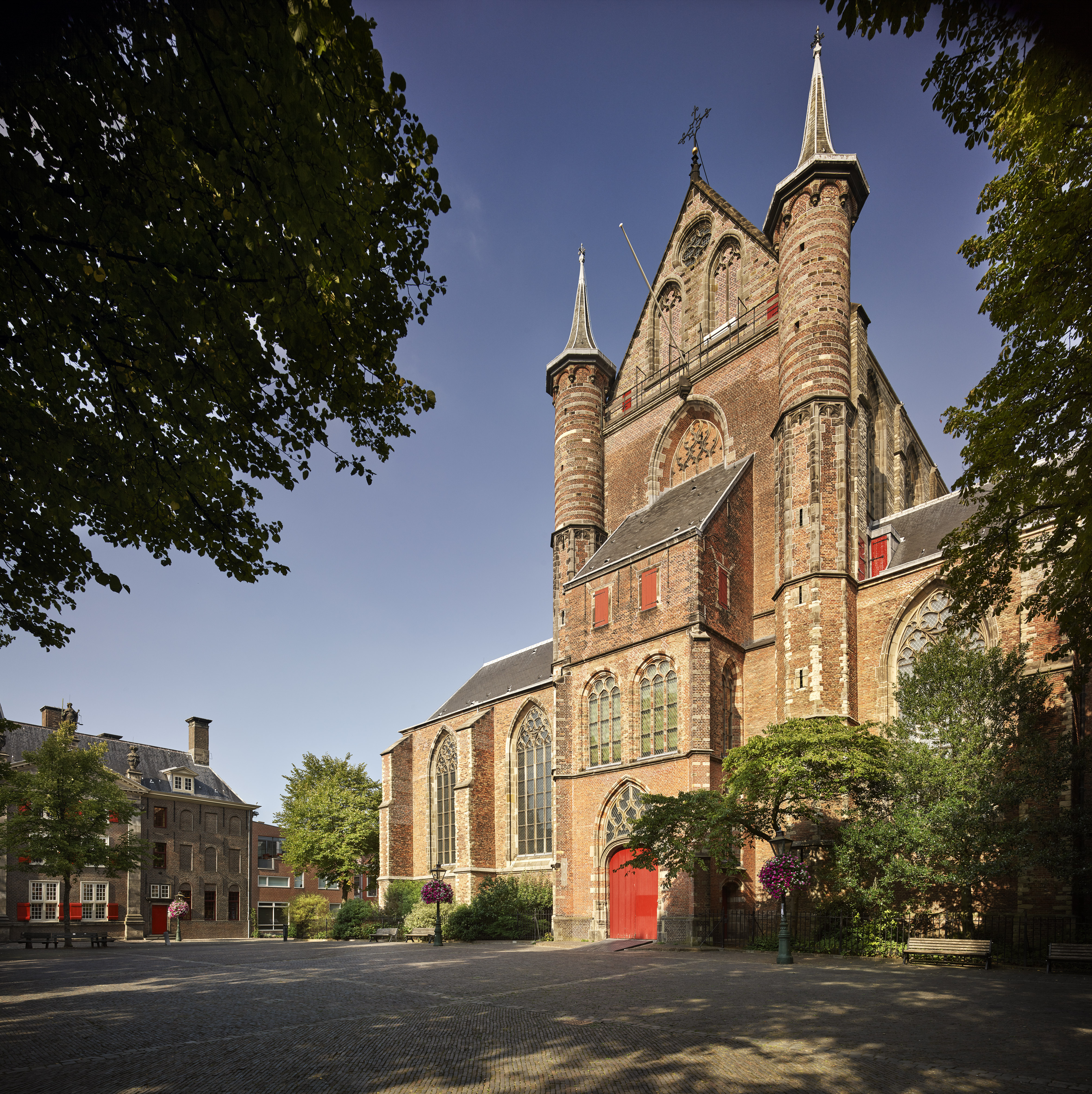
The Pieterskerk in Leiden
Leiden , known for being a liberal city of free thinkers, was home to the Separatists for 12 years.
They set about creating new lives for themselves, bought land near the Pieterskerk church and built houses that became known as the Engelse poort - which means English Alley.
John Robinson , one of the founders of the Separatist movement in England, became ‘pastor to the Pilgrims’ during his time in Leiden. He was one of the leaders in planning the journey to America on the Mayflower.
He was to accompany a second wave of Pilgrims to America, but he never made it to the New World, dying before the journey. He was buried at St Pieterskirk Church in Leiden where a plaque is situated.
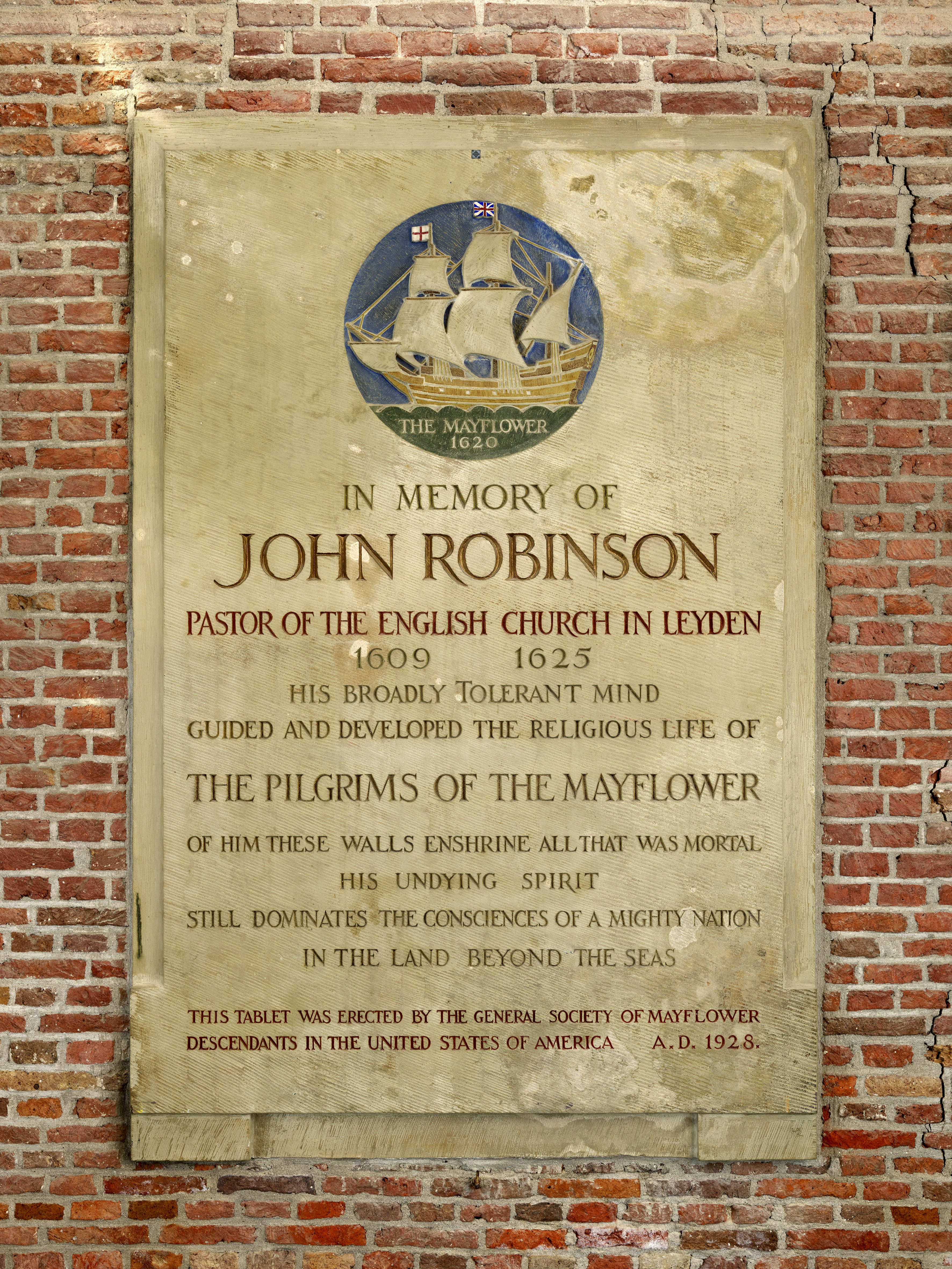
The plaque at the church
Also remembered in Leiden is one of John Robinson’s assistants and elders, William Brewster, who had come from England during the 1608 escape. He had lived and worked in an area of Leiden near Pieterskirk before he became one of the Pilgrim leaders.
He was a passenger on the Mayflower and settled in Plymouth, Massachusetts. The people of Leiden commemorated him by naming the street where he lived after him - William Brewstersteeg (Alley). Brewster’s house has nearly disappeared through development but the blank end wall can still be identified by the contrast of its bricks with those added later.
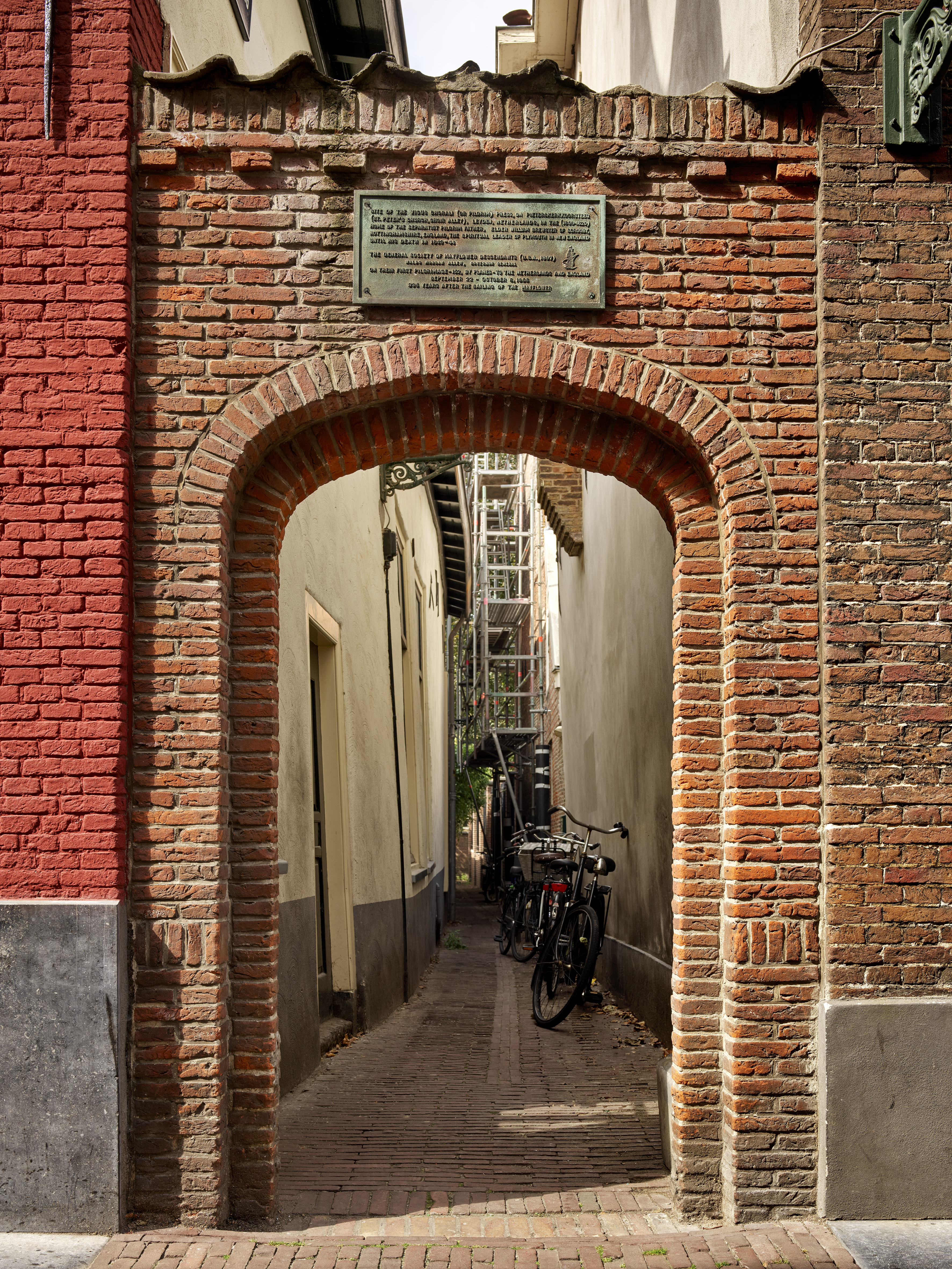
William Brewster Alley
During the 12 years they were in Leiden, the Separatists found life hard. They earned little money and were not used to the urban location - having come from rural English villages. Parents started worrying that their children were being heavily influenced by the Dutch and would eventually forget their English roots.
They were also worried a war between Holland and Spain was imminent and that this would mean danger for the freedom they had fled for.
- Learn more about visiting Leiden
Getting aboard
They decided to move on again, so were in touch with their Separatist counterparts back in England to forge a plan to all travel together to Virginia, America and start a new community there, where they could live and worship as they wanted. To help fund the expensive trip, they made an agreement with the Virginia Company in London - created to establish colonies on the coast of North America which needed people to settle in them and send back goods for trade.
It was another Separatist John Carver who had a key role in planning the journey. He and fellow Pilgrim Robert Cushman were successful in negotiating with the Virginia Company for land in America where they could legally land and settle. William Brewster also knew a prominent member of the company to negotiate with too.
John Carver also won the key financial backing that was to pay for the trans-Atlantic voyage. He approached businessman Thomas Weston in London and the Merchant Adventurers in 1620 and convinced them that if they funded the journey, they would see a return on their investment. Thomas Weston agreed and hired the Mayflower which sailed from London to Southampton to meet the Speedwell, the ship which brought the Pilgrims from Leiden.
Setting sail on July 22
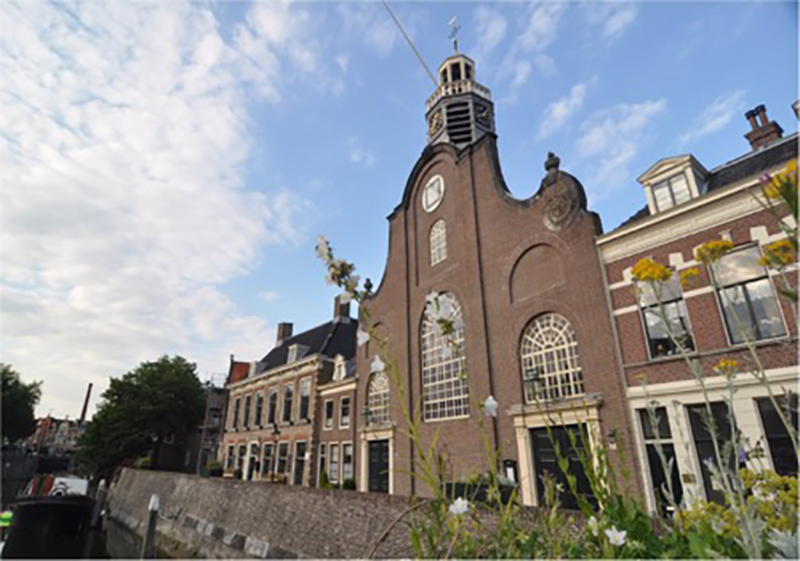
The Pilgrim Fathers Church
The Separatists in Holland had sold their personal belongings to buy the Speedwell. After one last joint meal and service in the house of Rev John Robinson, 16 men, 11 women and 19 children made the journey from Leiden to Delfshaven near Rotterdam to set sail to Southampton on July 22, 1620.
They travelled on foot, on horseback and by carriage carrying their possessions, ready to board the Speedwell ship, meet the Mayflower, and sail onto a new life in America.
The night before the Pilgrims departed was spent praying in front of the church, now known as the Pilgrim Fathers Church. Today there is a stained glass window depicting the historic moment the Pilgrims set off, and a bronze plaque of the Boston Congregational Club from 1906 praising the hospitality offered by the church to the pioneers.
The following morning residents of Delfshaven and friends of the Pilgrims gathered to see them leave. John Robinson led prayers and after an emotional goodbye, the Speedwell set a course along the River Maas out to the North Sea and en route to Southampton. A few days later the Speedwell arrived in Southampton and met up with the Mayflower which had sailed from Rotherhithe in London carrying the other Separatists from England. The plan was to stock up in Southampton and sail to America together. The town was a thriving seaport so as well as offering all the commercial facilities needed to equip the long sea voyage, it also had established trading links with Virginia and Newfoundland. Living there was a group of seamen who had experience of the Atlantic crossing which proved helpful. The Speedwell had been leaking during her journey from Holland, so was repaired in Southampton’s extensive ship building and repair facilities near West Quay. Southampton proved the right choice, not least for its offering of all the supplies required for the journey and to establish a permanent community in America. The Speedwell and Mayflower were anchored just off West Quay, and the Pilgrims spent all day shopping for supplies, before sleeping on the ships at night. And they were certainly in the right place - of the 153 merchants in the town in 1620, 118 were involved in the wool trade, but the remainder would have been able to help the Pilgrims with all the other items they would have needed to become self-sufficient. A Hampshire man called Stephen Hopkins joined the Mayflower in Southampton, and is known as the only passenger to have had any experience of the New World, having been shipwrecked in Bermuda in 1609.
Leaving English shores
After a hectic few days of repairs and preparations, both the Mayflower and Speedwell left Southampton on August 15, 1620. But the Speedwell took on water again - thought to be either because she carried too much sail, straining her timbers, or the result of sabotage by the reluctant crew. Both ships were diverted to Dartmouth, and over the course of a week the Speedwell was repaired. They set sail out into the English Channel towards the North Atlantic, but 300 miles off Land’s End the Speedwell leaked again and it’s decided they cannot risk continuing. They turned around and headed for Plymouth, having already spent up to six weeks at sea since originally departing London and Leiden. The Speedwell was finally declared unfit to sail, and after some Pilgrims dropped out and stayed in Plymouth, the remainder boarded the Mayflower for the voyage. On September 16, 1620, the Mayflower with 102 passengers and up to 30 crew onboard, left the Mayflower Steps on Plymouth’s Barbican. This was the last time the Pilgrims were on English soil before heading to the New World and a new life.
Sign up for the latest Mayflower 400 news
You'll be the first to hear the latest Mayflower news, events, and more.
Forgotten Password?
Mayflower 400 Proudly Supported by our National Sponsors and Funding Partners

- Website Privacy Policy
- Make a Pledge
The Great Arrival and the Dawn of Italian America
Poverty, natural disasters & war drove millions from italy. the great arrival transformed the nation's cultural landscape and led to the creation of italian america..

By: Tony Traficante , ISDA Contributing Editor
The Journey
They scrimped and saved to buy a ticket to America and today they gathered in the village piazza about to leave everything familiar—family, friends, and loved ones. There was a group of families, single men, husbands, fathers, and sons. Amid weeping and hugs, promises were made to send money home, and return soon, or send for them. Many, however, would never return, and some would never see families or friends again.
But, in spite of the anguish of departure, they were upbeat, hoping to find fortune, and a better way of life.
The Italians were leaving out of necessity and desperation. Four million Italians, many from the “ Mezzogiorno,” the southern areas of Italy, emigrated to the United States between 1890 and 1920. The southern regions of Italy suffered more significant hardships than the north, where there were better advantages of industry, education and quality of life.
Other factors contributed to the migration of the southern Italians, among them poverty, unemployment, a scarcity of farming land, high taxes, and natural disasters. During years of disastrous volcanic eruptions at Mount Vesuvius and Mount Etna, surrounding towns sustained enormous casualties. A violent earthquake, in 1908, rocked the southern part of Italy, creating a tsunami with such crushing force it decimated more than 100,000 Italians, and laid bare vast areas of Messina and Reggio di Calabria.
The Italians traveled from small southern communes and hamlets, going by whatever means available—train, bus, horse and cart, and even via “L’asino.” Arriving at a departing port, most likely Naples, the immigrants underwent humiliating fumigation of body, clothes, and goods, a document verification, then a cursory medical exam.
Herded aboard ships, they were directed to third class, crowded “steerage” compartments located at the very bottom of the boat. The steerage “halls” were lined with rows of metal bunks stacked two high. They were primitive, unsanitary, and claustrophobic. Privacy was non-existent, and amenities were basic.
Bedding consisted of straw mattresses covered with a piece of canvas sheeting. A life preserver was their pillow. They were given a lightweight blanket, and a set of metal eating utensils consisting of a fork, spoon, and tin lunch pail.
Third class meals were meager and far from gourmet. There were no dining tables or chairs; the Italians made do by sitting on bunks, floors, or when permitted “al fresco” on deck. Traveling steerage class was a most unpleasant experience surrounded by unbearable conditions. There was sickness, cramped quarters, putrid stenches of vomit, urine, and whatever else, with little ventilation.
This article first appeared in La Nostra Voce, ISDA’s 28-page monthly newspaper, which chronicles Italian-American life, culture and traditions. Subscribe today!
But, even among the discomfort and sickness, the resilient Italians made the best of the situation finding time for enjoyment and a bit of diversion. On occasion, they celebrated a marriage or birth. Then, there was always someone with a concertina to complement the immigrants’ songfest and dancing. The ladies passed time crocheting, while men played a bit of “ briscola, tre sette or morro.”
The journey to America was a long and harsh one. After days at sea, most immigrants landed at the infamous Ellis Island. As they walked into the cavernous dark halls, fearful and anxious, they were “ greeted” by immigration officials shouting orders. The Italians, not understanding what they were saying, complained, “che diavolo hanno detto.”
Their long, long day was about to begin. The primary concern was getting through the medical inspections. Chalk marks on the clothes of an immigrant identified his or her medical condition: H for heart problems, E for eye problems, L for lameness, and so forth . U.S. laws also required an intelligence exam to identify the “idiots, imbeciles, morons, or other mentally deficient persons.” Those with minor illnesses are held in quarantine for a day or two; others with severe medical conditions were put aside, and likely deported.
For the anguish of it all, Italians dubbed Ellis Island, “L’Isola Delle Lagrime”— the island of tears!
Having made landfall, those without sponsorship of family, or friends faced new concerns, like finding a place to live and work. They had no choice but to engage the services of a “Padrone ” for assistance. The Padrones were usually former immigrants themselves and were trustworthy and helpful; others were there to take advantage of the immigrants.
The Italians tended to settle and live together, forming communities often called “Little Italy.” They organized fraternal societies providing them benefits, stability, social interaction, and a basic indoctrination into the American way of life.
Many Italian immigrants decided to stay and sent for family member; as many went back to Italy. For those who remained, life ahead would be no easy road.
The Italian immigrants contributed much to the success of this great nation; their legacy is a proud and generous one. And, for the sake of our descendants, the story of our ancestors must be told, and never forgotten!
The successes of our ancestors are important occurrences in American history; they are undeniably part of our inheritance.
Make the pledge and become a member of Italian Sons & Daughters of America (ISDA) today.
Tony Traficante, ISDA Contributing Editor
- October 8, 2019
Image Credit
Wikipedia (screenshot); courtesy of Tony Traficante
Share your favorite recipe , and we may feature it on our website. Join the conversation , and share recipes, travel tips and stories.
A Celebration of Faith, Family and New Beginnings
Once again we follow deeply rooted traditions, and connect with the most important gifts in our lives.

Meet Our President
Basil Russo sits down with "We the Italians" to discuss ISDA, family, and the beauty of heritage.
The Feast of the Epiphany and the Flight of La Befana
For many, Christmas rituals and traditions extend well past Dec. 25.

Immigration to America in the 19th Century: A Gateway to New Horizons
Welcome to 19th Century ! In this blog, we delve into the fascinating world of the 19th century. In our latest article, we explore the immigration to America in the 19th century . Discover the trials and triumphs of those who embarked on a journey to the land of opportunity during this transformative era. Join us as we uncover their stories and shed light on this pivotal chapter in American history.
Table of Contents
The Wave of Immigration to America during the 19th Century: A Changing Nation
The wave of immigration to America during the 19th century significantly shaped the nation’s identity and population . During this period, millions of immigrants flocked to the United States in search of better opportunities and escape from poverty, political unrest, and religious persecution .
The Industrial Revolution and economic boom in America during the 19th century attracted immigrants from various parts of the world. Europeans, including Irish, Germans, Italians, and Eastern Europeans, constituted a significant portion of the immigrants. They were joined by Chinese laborers seeking job opportunities, particularly during the California Gold Rush and the construction of the transcontinental railroad.
This influx of immigrants led to a diversification of American culture, language, and traditions . Immigrant communities often settled in neighborhoods where they could maintain their cultural practices and establish support networks. These neighborhoods, known as ethnic enclaves, played a crucial role in preserving their heritage while adapting to their new lives in America .
However, the arrival of immigrants also gave rise to nativist sentiments and anti-immigration movements . Some Americans feared that the large numbers of immigrants would lead to economic strain, cultural clashes, and competition for jobs. This sentiment led to the implementation of restrictive immigration policies, such as the Chinese Exclusion Act of 1882 and the Immigration Act of 1891 .
Despite the challenges they faced , many immigrants contributed significantly to the growth and development of America during the 19th century . They played vital roles in industries such as mining, agriculture, manufacturing, and the building of infrastructure. Additionally, immigrants brought diverse skills, ideas, and cultural richness, enriching the fabric of American society .
The wave of immigration to America during the 19th century had a profound impact on the nation . It transformed the demographics, cultural landscape, and economic development. The experiences of these immigrants, both their struggles and contributions, continue to shape America’s identity as a nation of immigrants.
USCIS News: Visa Bulletin SEPTEMBER 2023 Priority Dates Updates, Green Card Updates, US Immigration
Largest immigrant groups in the us (1850 to 2019), what were the factors that led to immigration to the us during the 19th century.
There were several factors that contributed to immigration to the US during the 19th century.
1. Economic opportunities: The US offered abundant land and natural resources, as well as a growing industrial sector, which attracted immigrants seeking better economic prospects. Many Europeans faced poverty, overcrowding, and limited job opportunities in their home countries, so they saw America as a land of opportunity.
2. Political and religious freedom: The US was known for its democratic ideals, religious tolerance, and freedom of speech. Immigrants escaping political instability, religious persecution, or seeking to escape oppressive governments found refuge in the US.
3. Industrialization and urbanization: The Industrial Revolution led to rapid urbanization and increased demand for labor in cities. Immigrants, particularly from Europe, provided the workforce needed to fuel the industrial growth.
4. Transportation improvements: The advancements in transportation, such as steamships and railroads, made it easier and more affordable for people to travel long distances. This facilitated the migration of many Europeans to the US.
5. Chain migration: Once some individuals settled in the US, they would often encourage and assist their family members and friends to join them. This chain migration created networks that facilitated further immigration.
6. Famine and poverty: In the mid-19th century, Ireland experienced the Great Famine, causing mass starvation and forcing many Irish to leave their homeland. Similarly, economic hardships in regions like Italy, Eastern Europe, and Scandinavia pushed people to seek better lives in the US.
7. Gold Rush: The discovery of gold in California in 1848 sparked a massive wave of migration, known as the Gold Rush. People from all over the world flocked to California in hopes of striking it rich.
Overall, a combination of economic opportunities, political and religious freedom, industrialization, transportation improvements, chain migration, famine, and the Gold Rush played significant roles in driving immigration to the US during the 19th century.
How was immigration to America in the 19th century?
Immigration to America in the 19th century was a significant phenomenon that shaped the history and culture of the United States. During this period, millions of people from various parts of the world migrated to America in search of better economic opportunities, religious freedom, and escape from political upheavals.
Economic factors played a crucial role in driving immigration to America in the 19th century. The Industrial Revolution and rapid urbanization in the United States created a demand for cheap labor. Immigrants from Europe, primarily Ireland and Germany, were attracted by the prospect of employment in industries such as manufacturing, mining, and construction.
Political and religious reasons also motivated people to leave their countries and settle in America. The Irish potato famine in the 1840s forced many Irish Catholics to seek refuge in the United States. Similarly, political unrest in Germany during the Revolutions of 1848 spurred a wave of German immigration to America.
The journey to America was often arduous and hazardous. Most immigrants undertook long and treacherous voyages lasting several weeks on overcrowded ships, commonly referred to as “coffin ships.” Conditions onboard were typically unsanitary, with limited food and medical care. Many passengers did not survive the journey due to disease and malnutrition.
Upon arrival , immigrants were processed at ports such as Ellis Island in New York or Castle Garden (later replaced by Ellis Island) where they underwent health and legal inspections. While some immigrants already had plans to settle in specific regions, many others were directed to destinations based on labor needs or family connections.
Immigrants faced various challenges upon their arrival in the United States. Language barriers, cultural differences, and discrimination were common obstacles. However, immigrant communities formed strong bonds and created support networks to help newcomers adapt to their new lives.
The impact of immigration in the 19th century was profound. Immigrants brought their customs, traditions, and languages, enriching American society and influencing its cultural landscape. They contributed to the growth of cities, the development of industries, and the expansion of transportation networks. Immigrants also played a vital role in shaping American politics and society, as they brought diverse perspectives and experiences.
Immigration to America in the 19th century was driven by economic, political, and religious factors. The journey was perilous, but those who made it endured many challenges and made significant contributions to the development of the United States.
What was the impact of immigration on America in the 19th century?
The impact of immigration on America in the 19th century was significant and transformative. During this period, millions of immigrants arrived in the United States from various parts of the world, primarily from Europe. This wave of immigration had several key effects on the country.
Economic impact: Immigrants played a crucial role in fueling America’s industrial revolution by providing a steady supply of labor. They often filled low-paying jobs in industries such as manufacturing, mining, and construction. Immigrants also established small businesses and contributed to the growth of urban areas. Their presence boosted economic growth and helped build America into an industrial powerhouse.
Cultural impact: The influx of immigrants brought diverse traditions, languages, religions, and customs to the United States. This rich tapestry of cultures led to the formation of ethnic neighborhoods and vibrant communities in cities like New York, Chicago, and San Francisco. Immigrants often maintained their native languages and cultural practices, fostering a sense of identity and community while also adding to the multicultural fabric of the nation.
Social impact: Immigration in the 19th century led to social challenges, as native-born Americans grappled with the influx of new arrivals. Anti-immigrant sentiment, known as nativism, emerged as some feared competition for jobs and resources. This led to the establishment of restrictive immigration policies, such as the Chinese Exclusion Act of 1882. However, immigrants also faced discrimination and prejudice based on their ethnicity and religion, which negatively impacted their integration into American society.
Demographic impact: Immigration significantly increased the population of the United States during the 19th century. Immigrants settled in cities and helped shape their growth, making urbanization a defining characteristic of this era. Large immigrant populations also had political implications, as they became important voting blocs and influenced local politics in their respective communities.
Overall, the impact of immigration on America in the 19th century was a complex and multifaceted phenomenon. While it contributed to economic growth, cultural diversity, and demographic changes, it also led to social tensions and the rise of anti-immigrant sentiments. Nevertheless, the legacy of this period’s immigration continues to shape the United States today.
What was immigration like in the 19th century?
Immigration in the 19th century was a significant phenomenon that shaped the demographic and cultural landscape of various countries, particularly the United States. The 19th century witnessed waves of mass immigration due to factors such as poverty, political instability , and economic opportunities .
European immigrants were the most dominant group during this period, with large numbers coming from countries such as Ireland, Germany, Italy, and Eastern Europe . They sought refuge from famine, religious persecution, and economic hardships.
New York City became a major port of entry for these immigrants, with Ellis Island serving as the processing center for millions of arrivals. Upon arrival, immigrants faced medical inspections, legal screenings, and verification of their documents .
Challenges awaited immigrants in their new countries. The vast majority settled in urban areas, particularly in industrial centers, where they formed ethnic enclaves and faced difficulties with language barriers and finding employment.
Discrimination and prejudice were prevalent, leading to the formation of organizations and communities that provided support and protection to immigrant groups. These included ethnic neighborhoods, churches, and mutual aid societies .
Chinese immigration also surged in the 19th century, primarily driven by labor demands in the American West. However, anti-Chinese sentiment and legislation, such as the Chinese Exclusion Act, severely restricted Chinese immigration and imposed harsh restrictions on those already living in the United States.
The 19th century witnessed significant waves of immigration that transformed countries like the United States. These immigrants faced numerous challenges, but their contributions shaped the development and diversity of the nations they settled in.
Frequently Asked Questions
What were the primary reasons for immigration to america in the 19th century.
The primary reasons for immigration to America in the 19th century were:
1. Economic opportunities: Many people were drawn to America by the promise of finding work and improving their living conditions. The United States was experiencing rapid industrialization and urbanization during this period, creating jobs in sectors such as manufacturing, mining, and agriculture.
2. Escape from poverty and famine: Europe, particularly Ireland and Germany, experienced economic hardships and famines in the 19th century. Many people sought a better life in America, where they hoped to escape poverty and enjoy greater economic stability.
3. Religious freedom: America was known for its commitment to religious freedom and tolerance. Religious minorities and persecuted individuals from various countries, such as Jews, Catholics, and members of non-conformist Protestant groups, sought refuge in America.
4. Political instability and conflicts: Europe witnessed several political upheavals, including the revolutions of 1848, which led to widespread migration. People fleeing political persecution and seeking stability found America to be an attractive destination.
5. Land availability: The Homestead Act of 1862 provided free land to settlers who were willing to develop and cultivate it. This drew many people to the American West, particularly farmers looking for new opportunities.
6. Transportation advancements: The development of steamship technology made transatlantic travel faster and more affordable, making immigration to America more accessible to a larger number of people.
It is important to note that immigration experiences varied depending on factors such as ethnicity, social class, and country of origin.
How did the influx of immigrants in the 19th century impact American society and economy?
The influx of immigrants in the 19th century had a significant impact on American society and economy. Between 1820 and 1920, millions of immigrants from countries such as Ireland, Germany, Italy, and Eastern Europe arrived on American shores in search of better opportunities and escaping political and economic hardships.
Socially , these new arrivals brought diverse cultural traditions, languages, and religions, which contributed to shaping the multicultural fabric of American society. They established ethnic enclaves in cities, where they formed communities and preserved their customs and languages. This diversity added richness and vitality to American culture, enriching art, music, cuisine, and literature.
Economically , immigrants played a crucial role in the industrialization and rapid growth of the United States. They provided an abundant source of labor for industries such as mining, manufacturing, and construction. Immigrants often took low-paying jobs that native-born Americans were reluctant to accept. Their labor helped fuel the expansion of the railroads, the development of urban infrastructure, and the growth of the agricultural sector.
Along with their labor contributions, immigrants also stimulated economic growth through entrepreneurship. Many immigrants started businesses and created jobs, contributing to the overall prosperity of the nation. For example, German immigrants played a significant role in the development of the brewing industry, while Italian immigrants made substantial contributions to the culinary and fashion industries.
However, the influx of immigrants also created challenges and tensions. Nativist sentiments arose among some native-born Americans who feared competition for jobs and resources. This led to the establishment of restrictive immigration policies and discriminatory practices against certain immigrant groups.
Overall, the inflow of immigrants in the 19th century brought both benefits and challenges to American society and economy. While it enriched the cultural landscape, fueled economic growth, and contributed to the nation’s development, it also sparked social and economic tensions that shaped the ongoing debate on immigration in American society.
What were the experiences and challenges faced by immigrants during their journey to and upon arrival in America in the 19th century?
In the 19th century, immigrants faced numerous experiences and challenges during their journey to and upon arrival in America. Leaving their homelands behind, these individuals embarked on often treacherous voyages across the Atlantic Ocean to seek better opportunities in the United States.
During the journey, immigrants faced harsh conditions, overcrowded ships, and limited access to basic necessities. Many were confined to steerage, the lower and less comfortable decks of the ship, where they endured cramped quarters, poor sanitation, and inadequate food and water supplies. Illnesses, such as cholera and dysentery, easily spread in these unsanitary conditions, leading to high mortality rates.
Upon arrival in America, immigrants encountered various challenges and hardships as they settled into their new lives. Language barriers were among the most significant hurdles. For non-English-speaking immigrants, communication was difficult, making it harder to find employment or establish connections within their communities. Many immigrants also faced discrimination and prejudice, often based on their nationality, ethnicity, or religious beliefs.
Additionally, economic difficulties were pervasive. Immigrants typically arrived with limited financial resources, if any at all. Finding stable employment and securing decent wages were major concerns for many newcomers. Competition for jobs was often fierce, as native Americans were sometimes hostile towards the influx of foreign workers willing to accept lower pay.
Living conditions in urban areas were often crowded and unsanitary. Immigrants frequently settled in overcrowded tenements and slums, lacking proper sanitation, fresh air, and clean water. Poverty and disease were rampant in these areas, exacerbating the challenges faced by immigrant families.
Despite the trials they endured, immigrants played a vital role in shaping the development of America in the 19th century. They contributed to the growth of industries, such as mining, manufacturing, and agriculture, and played a significant role in the expansion of the country’s population and cultural diversity. Over time, they formed close-knit communities, established schools and places of worship, and worked towards preserving their cultural heritage while also assimilating into American society.
However, the experiences and challenges faced by immigrants during this era highlight the resilience and determination of those who sought a better life for themselves and their families. Their contributions continue to shape the fabric of American society today.
Immigration to America in the 19th century played a pivotal role in shaping the nation’s identity and development. The influx of millions of immigrants from various parts of the world transformed the country into a melting pot of cultures, ideas, and opportunities. It was during this time that the United States experienced a dramatic population growth, urbanization, and industrialization. Immigrants sought refuge from economic hardships, political unrest, and religious persecution in their home countries, and America offered them a chance for a better life.
However, this wave of immigration also brought about social and economic challenges. Native-born Americans often viewed immigrants as a threat to their jobs, religion, and way of life. This led to the rise of anti-immigrant sentiments and the implementation of restrictive policies, such as the Chinese Exclusion Act and the Immigration Act of 1882. Despite facing discrimination and hardships, immigrants contributed immensely to the growth of American society, economy, and culture.
Today, the legacy of 19th-century immigration continues to shape the United States. The descendants of these early immigrants have made significant contributions in various fields, including politics, art, science, and business. The rich tapestry of multiculturalism and diversity that emerged during this period remains an integral part of the American identity.
As we reflect on this era of immigration, it is important to recognize the courage, resilience, and determination of those who journeyed to America in search of a better future. The stories of individuals and families who left their homelands to start anew in an unfamiliar land are a testament to the enduring spirit of the human quest for freedom and opportunity.
Overall, immigration to America in the 19th century serves as a reminder of the transformative power that migration has on societies. It teaches us the importance of embracing diversity, fostering inclusivity, and appreciating the contributions of all individuals, regardless of their origins.
To learn more about this topic, we recommend some related articles:

The Dark Legacy of Xenophobia in the 19th Century: Uncovering the Roots of Fear and Hatred

Journey of Hope: Exploring Immigrant Diaries from the 19th Century
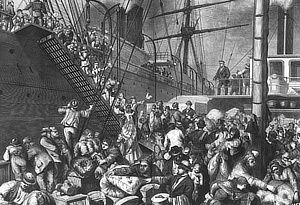
The Impact of 19th Century German Immigrants: Cultivating a New Home in America
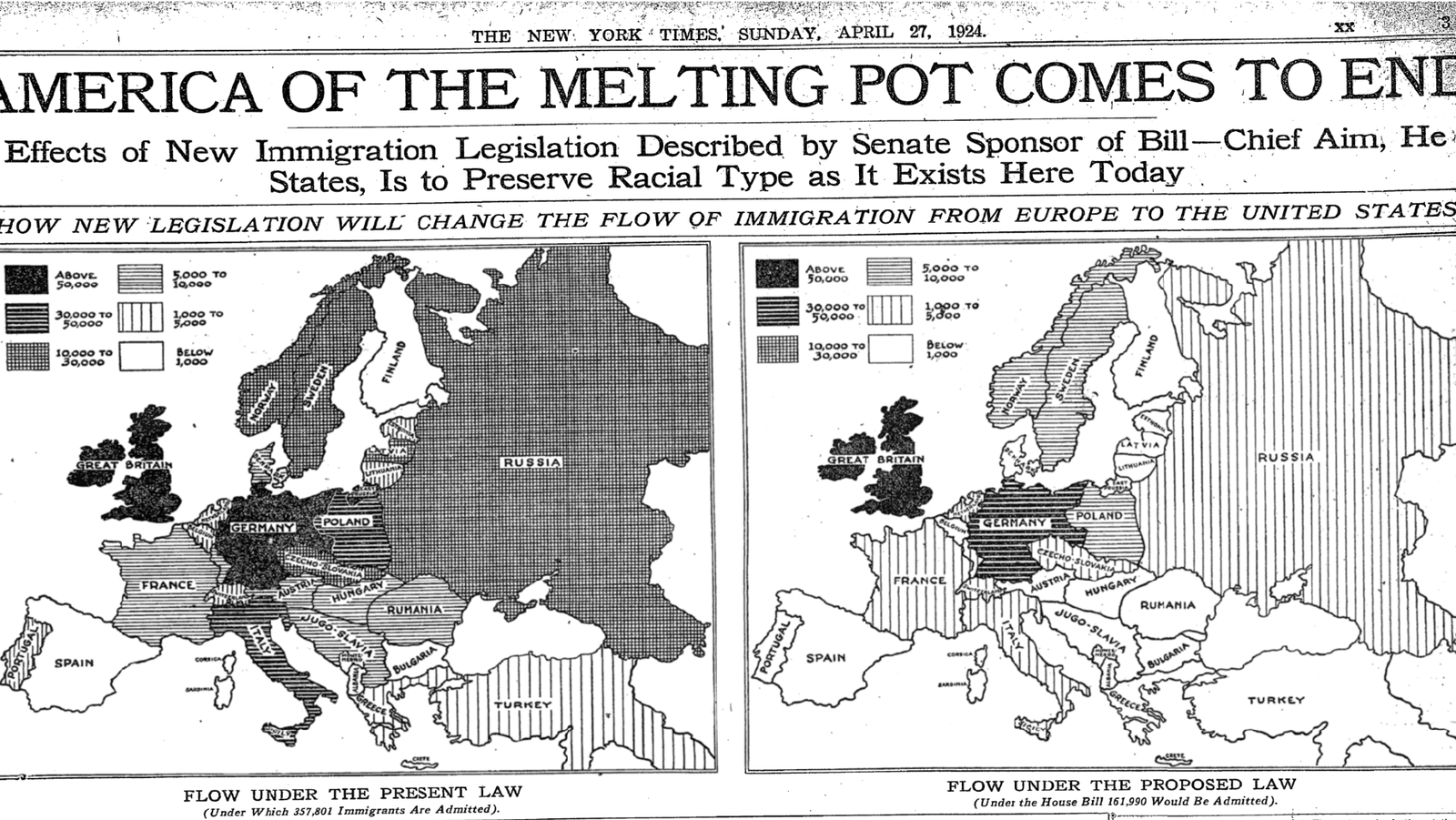
Exploring the Impact of 19th Century Immigration Laws: A Historical Perspective

Navigating the Trials: Challenges Faced by Immigrants in the 19th Century
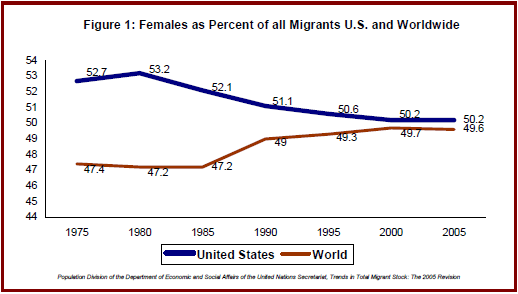
Why Were the Majority of Immigrants in the 19th Century Male? Unraveling the Gender Disparity in Immigration Trends

Sailing Time from England to America in the 1600s: A Historical Account
Alex Morgan
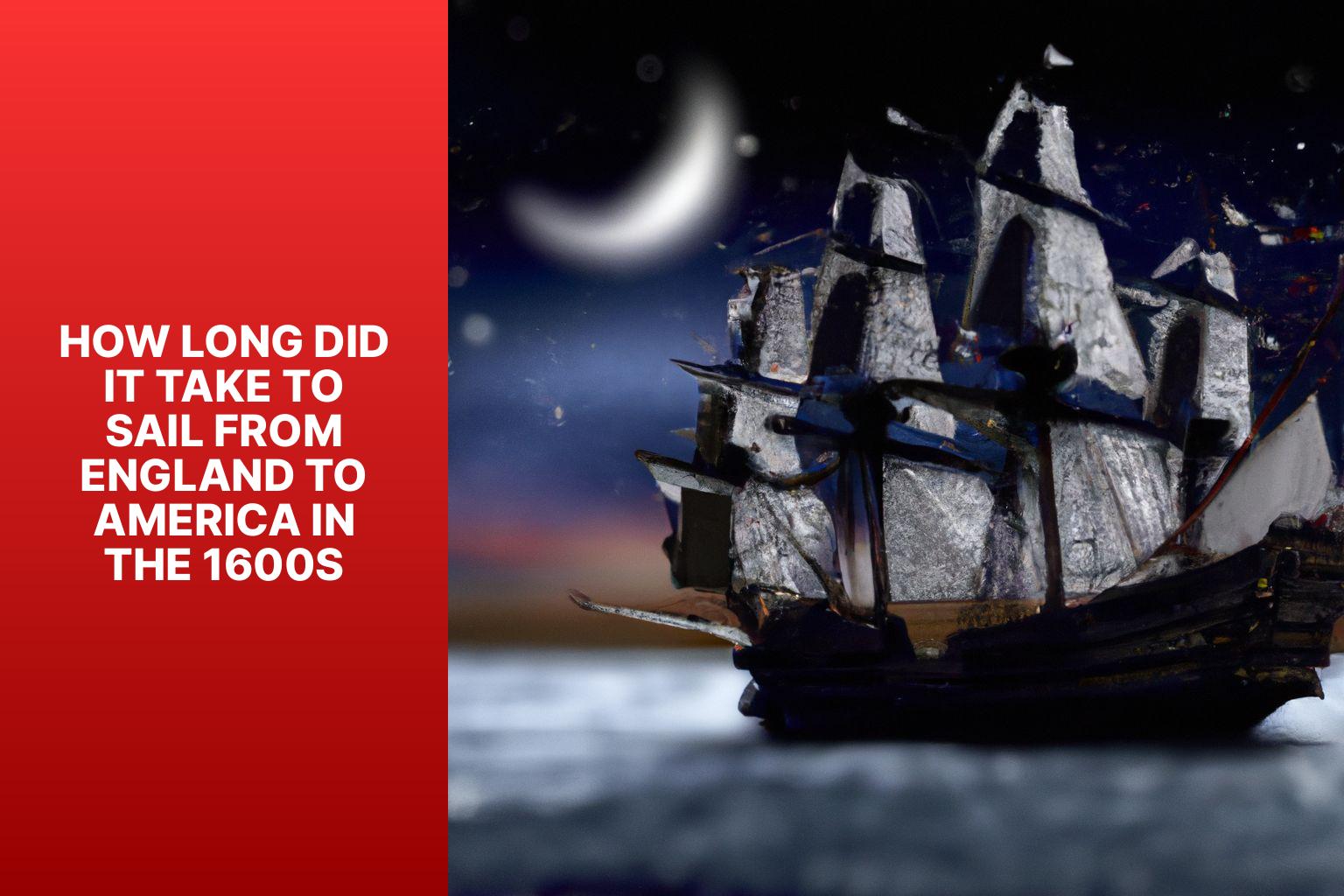
Sailing from England to America in the 1600s was a significant journey that had a profound impact on exploration and colonization. Understanding the duration of these transatlantic voyages during this period provides valuable insights into the challenges faced by early explorers and settlers.
During the 1600s, several main transatlantic sailing routes were established, connecting England to different regions in America. These routes played a pivotal role in the expansion of European influence and the establishment of colonies in the New World.
The types of ships used for transatlantic voyages in the 1600s varied depending on the specific purpose of the journey. From large merchant vessels to smaller ships designed for exploration and colonization, these ships were instrumental in facilitating the movement of people, goods, and ideas across the Atlantic.
The duration of these transatlantic voyages in the 1600s was influenced by various factors. Weather conditions, navigation techniques, and the speed of the ship were key considerations. The specific destination and purpose of the journey impacted the length of time it took to sail from England to America.
On average, the transatlantic journey from England to America in the 1600s took a significant amount of time. Depending on the factors mentioned earlier, it could take several weeks to several months to complete the voyage.
There were notable voyages and expeditions during this period that played a crucial role in the exploration and colonization of America. These pioneering journeys paved the way for further expansion, trade, and settlement in the New World.
By understanding the duration of sailing from England to America in the 1600s, we can gain a deeper appreciation for the challenges faced by early explorers and recognize the impact these voyages had on shaping the course of history.
Key takeaway:
- The duration of sailing from England to America in the 1600s was significant due to the challenges and risks involved in long transatlantic voyages during that time period.
- Various transatlantic sailing routes were used during the 1600s, with the main routes being from England to the eastern coast of North America and the Caribbean.
- Sailing vessels used for transatlantic voyages in the 1600s were primarily large sailing ships, such as galleons and fluyts, which were capable of carrying passengers, cargo, and supplies for the long journey.
Why is the Duration of Sailing from England to America in the 1600s Significant?
The duration of sailing from England to America in the 1600s is significant for several reasons. It provides insight into the challenges and risks faced by early explorers and settlers. The journey could take six to twelve weeks, depending on factors such as weather conditions and ship type. These long and treacherous voyages required immense courage and perseverance.
The journey duration impacted trade and commerce between the two continents. The time it took to sail from England to America affected the speed of transporting goods and supplies, which had implications for merchants and traders relying on timely deliveries.
The voyage duration influenced colonization and settlement patterns in America. The longer it took to reach the destination, the more challenging it was to establish and maintain colonies. This factor affected the pace of expansion and the ability to provide necessary resources and support to the settlers.
The duration of sailing in the 1600s shaped the history and cultural exchange between the two regions. The slow and arduous journey allowed for interactions, exchanges, and sharing of ideas that contributed to the development of the American colonies.
Understanding the duration of sailing in the 1600s provides valuable insights into the historical, economic, and social aspects of the transatlantic relationship between England and America during that time period.
Why is the Duration of Sailing from England to America in the 1600s Significant ?
Sailing Routes in the 1600s
In the 1600s, different sailing routes served specific purposes. The well-known Atlantic Crossing route took 6 to 12 weeks to sail from England to America. The Tropical Route allowed sailors to reach the Caribbean Islands from England in 4 to 8 weeks. The Transatlantic Slave Trade Route transported enslaved Africans to America and the Caribbean, with a typical journey lasting 5 to 12 weeks. The Triangle Trade Route involved a complex network of voyages between England, Africa, the Caribbean, and America, with varied routes and times depending on the specific trade route.
Fact: The Triangle Trade Route significantly contributed to the British Empire’s economy growth in the 1600s by facilitating the exchange of goods, including slaves, across the Atlantic Ocean.
What were the Main Transatlantic Sailing Routes during the 1600s?
During the 1600s, the main transatlantic sailing routes connected Europe and North America . The common route was from England to America , specifically to the colonies on the eastern coast like Virginia , Massachusetts , and Maryland . Another route was from England to the Caribbean islands, which were English colonies at that time.
Routes also connected Europe to South America , primarily to Brazil and the Spanish colonies in Mexico and Peru . These routes were important for trade and exploration, as European powers aimed to establish colonies and exploit the resources of the New World.
The transatlantic voyages during the 1600s played a crucial role in the development of the British Empire and the colonization of America . These sailing routes facilitated the transportation of goods, people, and ideas between the Old World and the New World , contributing to the growth of trade and international relations.
One notable story is the voyage of the Mayflower in 1620, which carried the Pilgrims from England to America and led to the establishment of the Plymouth Colony in present-day Massachusetts . This journey was part of a larger wave of migration known as the Great Migration, where thousands of English settlers came to America in the 17th century in search of economic opportunities, religious freedom, and a fresh start.
The transatlantic sailing routes of the 1600s were instrumental in connecting faraway lands and shaping history through exploration, colonization, and trade. They paved the way for further European expansion and the eventual establishment of the United States as we know it today.
Sailing Vessels in the 1600s
During the 1600s, Sailing Vessels in the 1600s were crucial for transportation and exploration. These Sailing Vessels in the 1600s relied on wind power and the skill of their crews to navigate the seas. They were large, with multiple masts and square-rigged sails. The ships were heavily loaded with supplies and cargo, making the journeys challenging and dangerous.
The speed of the Sailing Vessels in the 1600s varied depending on weather conditions and crew skill. On average, a voyage from England to America in the 1600s took six to twelve weeks. Factors like wind patterns, currents, and storms affected the journey duration.
Sailing Vessels in the 1600s connected continents, facilitated trade, and aided exploration—an important era in maritime history.
What Types of Ships were Used for Transatlantic Voyages in the 1600s?
Ships used for transatlantic voyages in the 1600s were designed to withstand long and arduous journeys across the Atlantic Ocean. The galleon and caravel were two common types of ships used during this time. Galleons were large, heavily armed sailing ships that carried a significant amount of cargo, while caravels were smaller and more maneuverable, often used for exploration missions. The fluyt , a Dutch merchant ship, was another popular choice known for its large cargo capacity, making it ideal for long-distance travel between Europe and America. These sturdy and reliable ships played a crucial role in the exploration , colonization, and trade between Europe and the Americas during the 1600s. What Types of Ships were Used for Transatlantic Voyages in the 1600s?
Factors Affecting the Duration of the Journey
The duration of the journey from England to America in the 1600s was influenced by several factors. Wind patterns played a significant role in determining the speed of the journey. Ships would use favorable winds to make faster progress. Stormy weather, including hurricanes and heavy storms, could delay or halt the journey. The choice of the sailing route also affected the duration. Some routes were longer but had favorable winds, while others were shorter but had more challenging waters. The type and condition of the ship directly impacted its speed and ability to withstand the harsh conditions at sea. Well-maintained ships with experienced crews completed the journey more quickly.
During the 1600s, the average duration of the journey from England to America was around 8 to 12 weeks, varying depending on these factors. These voyages were challenging and perilous, with many hardships faced by the crew and passengers. Over time, improvements in sailing technology and navigation techniques led to shorter journey durations and safer crossings.
What Factors Influenced the Length of the Voyage in the 1600s?
In the 1600s, a variety of factors influenced the length of voyages from England to America. These factors included weather conditions, ship type, ship condition, crew skill and experience, and unforeseen events. One key factor was the trade winds , which played a crucial role in determining the speed and direction of ships. The use of larger sails and better navigational instruments allowed for faster and more efficient sailing.
Experienced sailors and navigators were able to make better use of the wind and navigate accurately, which also affected the length of the voyage. Knowledge of sea routes and the ability to navigate dangerous waters were also important factors that impacted the journey duration.
Unforeseen events such as storms, equipment failures, and encounters with pirates could significantly prolong the voyage. These unexpected circumstances had to be navigated and resolved by the crew, further adding to the length of the journey.
It’s worth noting that skilled navigators like Christopher Newport were able to complete the transatlantic voyage in as little as nine weeks. This highlights the importance of favorable winds, well-trained crews, and well-maintained ships in reducing the overall duration of the voyage.
Average Duration of the Transatlantic Journey
The average duration of the transatlantic journey in the 1600s, also known as the Average Duration of the Transatlantic Journey , was influenced by various factors such as weather conditions and the type of ship used. Historical records from that time period give us an estimate of the typical duration.
Based on these records, the average duration of the journey from England to America in the 1600s typically ranged from 6 to 12 weeks, also known as the Average Duration of the Transatlantic Journey . Ships faced numerous challenges during their voyages, including storms, rough seas, and limited navigational technology.
To provide more insight into the different types of ships commonly used during this period, the table below shows the Average Duration of the Transatlantic Journey for each ship category:
It’s important to note that these durations represent averages and can vary based on individual circumstances. It is truly fascinating to imagine the challenges and the sense of adventure that accompanied each journey across the Atlantic Ocean in the 1600s, particularly when considering the Average Duration of the Transatlantic Journey .
How Long Did It Typically Take to Sail from England to America in the 1600s?
Sailing from England to America in the 1600s typically took several weeks to several months. The duration of the journey depended on factors like weather conditions, wind patterns, and ship type.
The average voyage lasted from 30 to 90 days, with the fastest recorded journey completed in under 25 days. Speed was the exception rather than the norm.
The journey’s duration was greatly influenced by prevailing winds and currents, presenting challenges in navigating the Atlantic Ocean. Unfavorable winds could significantly delay the ship, extending the journey by weeks.
The ship type also affected the voyage duration. Merchant ships like English galleons or fluyts prioritized cargo transport over speed.
These estimates provide a general understanding of the typical duration for sailing from England to America in the 1600s, but actual voyage times could vary.
Notable Voyages and Expeditions
Notable voyages and expeditions in the 1600s were crucial for exploring and colonizing America. Here are some significant journeys:
– The Mayflower voyage: In 1620, the Mayflower sailed from England with 102 passengers, seeking religious freedom in America. This iconic voyage led to the establishment of the Plymouth Colony .
– Hudson’s voyage: In 1609, Henry Hudson, an English navigator, sailed for the Dutch East India Company to find a northern route to Asia. Instead, he explored and mapped areas including present-day New York .
– John Cabot’s expedition: In 1497, John Cabot, an Italian navigator sailing under the English flag, embarked on a voyage to find a westward route to Asia. He reached the continent now known as North America , opening the door for future English exploration and colonization.
– Jamestown founding: In 1607, the English established the Jamestown Colony in Virginia , the first successful English settlement in North America. This voyage paved the way for European colonization and the eventual establishment of the United States of America .
– The Roanoke expeditions: The Roanoke Colony, established in 1585 and again in 1587, was one of the first English attempts to establish a permanent settlement in America. The fate of the colony remains a mystery.
These notable voyages and expeditions laid the foundation for exploring, colonizing, and developing America in the 1600s.
What Were Some of the Pioneering Voyages from England to America in the 1600s?
In the 1600s, there were several pioneering voyages from England to America. These voyages played a crucial role in exploring and colonizing the New World .
One of the famous voyages was the Mayflower voyage in 1620. It brought the Pilgrims to present-day Plymouth, Massachusetts and marked the beginning of successful European settlement in the region.
Another significant voyage was the Jamestown expedition in 1607. Captain John Smith and a group of English settlers established the first permanent English colony in Virginia .
Moving forward to 1630, the Winthrop Fleet sailed to New England under the leadership of John Winthrop . They established multiple settlements, including Boston , and played a vital role in the development of the Massachusetts Bay Colony .
It’s important to mention that English explorers like Henry Hudson also embarked on important voyages during this time. In 1609, Hudson explored the area that would eventually become New York by sailing up the river which is now named after him.
These pioneering voyages were instrumental in shaping the history and culture of the United States as they laid the foundation for English colonization of the New World .
Impact of Transatlantic Voyages in the 1600s on Exploration and Colonization
Transatlantic voyages in the 1600s had a profound impact on exploration and colonization. These voyages opened up numerous opportunities for European nations to establish colonies and expand their empires, leading to the discovery of new lands, resources, and indigenous cultures.
Renowned European explorers like Christopher Columbus , John Cabot , and Henry Hudson played a crucial role in increasing knowledge about the geography and inhabitants of the Americas, paving the way for future expeditions and trade routes. The establishment of European colonies in the Americas allowed for the exploitation of valuable resources like gold, silver, and natural commodities. This contributed to the growth of trade and the expansion of European influence and power.
Cultural exchange between Europe and the Americas flourished as well. European settlers brought with them their customs, languages, and religions, while indigenous peoples introduced new foods, plants, and knowledge to the Europeans. This intermingling of cultures resulted in the formation of new cultural identities and the blending of diverse traditions. The colonization of the Americas provided economic opportunities, as valuable resources such as tobacco, sugar, and cotton were discovered. These resources fueled the growth of a global trade network, benefiting European powers and contributing to the economic development of their home countries.
The establishment of colonies during this time period significantly shifted the balance of power and influence among European nations. It gave them a competitive edge in terms of resources, trade dominance, and territorial control. This power shift set the stage for future conflicts and rivalries among European powers.
The impact of transatlantic voyages in the 1600s cannot be overstated. These voyages played a vital role in shaping history and laying the foundation for the global interconnectedness that we observe today. Their impact on exploration and colonization paved the way for further advancements and interactions between different parts of the world.
Some Facts About How Long It Took To Sail From England To America In The 1600s:
- ✅ The voyage from England to America in the 1600s took approximately 66 days. (Source: microblife.in)
- ✅ Henry Hudson took more than two months to sail from Amsterdam to New York City in the 1600s. (Source: microblife.in)
- ✅ The Mayflower took 66 days to cross the Atlantic in 1620. (Source: microblife.in)
- ✅ In the early 1700s, it took six to eight weeks to travel from England to the colonies. (Source: microblife.in)
- ✅ Columbus took two months to cross the Atlantic in 1492, and in the 18th and 19th centuries, it still took on average six weeks. (Source: microblife.in)
Frequently Asked Questions
How long did it take to sail from england to america in the 1600s.
In the 1600s, it took approximately 66 days to sail from England to America.
What were the main factors influencing the sailing time from England to America in the 1600s?
The sailing time from England to America in the 1600s was influenced by factors such as ship size, number of sails, time of year, hull shape, type of cargo, weather conditions, techniques of navigation, and personal knowledge of ship captains.
How long did the Mayflower voyage take from England to America in the 1600s?
The Mayflower voyage took 66 days to sail from England to America in the 1600s.
Did the journey from England to America in the 1600s have any significant delays?
Yes, the journey from England to America in the 1600s had significant delays. The Mayflower encountered multiple leaks, had to return to England for repairs, and faced storms in the Atlantic Ocean, extending the voyage time.
What was the average speed of ships sailing from England to America in the 1600s?
In the 1600s, ships sailing from England to America had an average speed of 4 to 6 knots.

How long did it take to sail from England to America in the 1600s compared to other means of transportation?
Sailing from England to America in the 1600s provided a shorter travel time for colonists compared to other means of transportation available at that time.
About the author
Leave a Reply Cancel reply
Your email address will not be published. Required fields are marked *
Save my name, email, and website in this browser for the next time I comment.
Latest posts

The history of sailing – from ancient times to modern adventures
History of Sailing Sailing is a time-honored tradition that has evolved over millennia, from its humble beginnings as a means of transportation to a beloved modern-day recreational activity. The history of sailing is a fascinating journey that spans cultures and centuries, rich in innovation and adventure. In this article, we’ll explore the remarkable evolution of…

Sailing Solo: Adventures and Challenges of Single-Handed Sailing
Solo Sailing Sailing has always been a pursuit of freedom, adventure, and self-discovery. While sailing with a crew is a fantastic experience, there’s a unique allure to sailing solo – just you, the wind, and the open sea. Single-handed sailing, as it’s often called, is a journey of self-reliance, resilience, and the ultimate test of…

Sustainable Sailing: Eco-Friendly Practices on the boat
Eco Friendly Sailing Sailing is an exhilarating and timeless way to explore the beauty of the open water, but it’s important to remember that our oceans and environment need our protection. Sustainable sailing, which involves eco-friendly practices and mindful decision-making, allows sailors to enjoy their adventures while minimizing their impact on the environment. In this…

Journey to America #1
Journey to america, sonia levitin.
160 pages, Paperback
First published January 1, 1970
About the author

Ratings & Reviews
What do you think? Rate this book Write a Review
Friends & Following
Community reviews.

Join the discussion
Can't find what you're looking for.
College Baseball, MLB Draft, Prospects – Baseball America
Lake Bachar’s Long Journey Carries Him To Cusp Of Padres Debut

Drafted as a starting pitcher out of Division III Wisconsin-Whitewater, righthander Lake Bachar certainly had a changeup in his mix.
Just not a good changeup.
That’s why Bachar had toyed with splitter grips dating back years. But the Tommy John surgery that wiped away his 2021 season allowed for a complete reset.
A light bulb went off in the spring of 2023 while Bachar was participating in a splitter camp with Hideo Nomo in Peoria, Ariz.
“I needed to take more velocity off and get more vertical break,” Bachar said. “Killing spin was what I needed to do. I have big hands, so I tried it out.”
A year later, that splitter, along with a mid-80s slider that one Padres official deemed a “real pitch” and fastball that sits 94-97 mph had helped the 28-year-old righthander gain traction as a reliever.
In 10 appearances for Triple-A El Paso in April, Bachar struck out 18 and walked four in 14.2 innings. That included four scoreless appearances of at least two innings.
The Padres drafted Bachar in the fifth round in 2016. His status as a prospect never rivaled that of draft-mates Cal Quantrill , Eric Lauer , Joey Lucchesi or David Bednar , but he was on the rise as a Texas League all-star in 2019.
But then the pandemic wiped out the 2020 season. Tommy John surgery and the death of his father to cancer followed in 2021.
Bachar took a step forward in 2023 as a reliever for Double-A San Antonio after settling on his splitter grip. Now, after nine long years in the organization—including two re-ups as a minor league free agent—is finally forcing his way up the Padres’ depth chart.
“I’m feeling really good,” Bachar said. “I feel like the past eight years has been funneling everything into being the best pitcher I can be out there . . .
“I’m the best version of myself right now and I’m just trying to get better.”
FATHER FIGURES
— A year after beginning 17-year-old catcher Ethan Salas’ career at Low-A Lake Elsinore, the Padres chose the California League to debut Leodalis De Vries on April 23. The 17-year-old Dominican shortstop appeared in the Padres’ Spring Breakout game and two exhibitions at Petco Park against the Mariners. At extended spring training, De Vries hit .480/.567/.960 with seven extra-base hits in 31 plate appearances.
— Former KBO star reliever Woo-Suk Go traveled with the Padres to South Korea for the Seoul Series, but he was not activated for those two games and was subsequently optioned to Double-A San Antonio to begin his transition to the United States.

When Was Your Favorite MLB Team Last On The Cover Of Baseball America?
In reverse chronological order, here’s the last time each MLB team was represented on our cover, including the team that has gone the longest—way back to December 2015.

Tracking 2024 In-Season Top 100 Prospect Movement
All season, we’ll track how players have moved up, down, in or out of the 2024 Baseball America Top 100 Prospects list.

College Podcast: South Carolina’s Big Upset, A Battle For First Place & More
Teddy Cahill and Peter Flaherty break down all the college baseball action from around the country before week 12 of the season. They start with…

Why Jackson Holliday Still Ranks No. 1 In Our Top 100 Prospects
Here’s why Jackson Holliday remains our No. 1 prospect for our May Top 100 Prospects update.
Latest Podcasts

How Will Tyler Black Impact The Brewers? | BA Prospect Profile
The Milwaukee Brewers called up Tyler Black, their No. 4 prospect and the No. 73 MLB prospect, on Tuesday and he went 2-for-4 in his…

How Will Jordan Beck Impact The Rockies? | BA Prospect Profile
The Rockies have promoted former first-round draft pick Jordan Beck who will join the Colorado outfield after posting a .999 OPS in the minor leagues…

The Biggest Breakout Prospects Of April | Hot Sheet Show Ep. 5
Scott Braun, JJ Cooper, Geoff Pontes and Ben Badler discuss the latest Prospect Profile spotlighting Colorado Rockies No. 4 prospect Jordan Beck’s promotion. Iowa Hawkeyes…

Fantasy Podcast: All-April Waiver Wire Draft
This week on the Baseball America Fantasy Podcast, hosts Geoff Pontes and Dylan White cover some of the news of the last week to open…

90th Percentile: The Chase For Velocity
Everyone is talking velocity and the injury epidemic, but on this week’s episode we ask, “What’s the alternative?” To discuss this far-reaching topic, we invited…

Talking Pitching Injuries And Rehab With Alan Jaeger And Randy Sullivan
The recent run of significant elbow injuries among prominent MLB starters has everyone including us thinking and talking about pitching injuries. On today’s podcast, JJ…
Download our app
Read the newest magazine issue right on your phone

Stay connected
Join our social media community
- History Classics
- Your Profile
- Find History on Facebook (Opens in a new window)
- Find History on Twitter (Opens in a new window)
- Find History on YouTube (Opens in a new window)
- Find History on Instagram (Opens in a new window)
- Find History on TikTok (Opens in a new window)
- This Day In History
- History Podcasts
- History Vault
The Pilgrims’ Miserable Journey Aboard the Mayflower
By: Dave Roos
Updated: September 6, 2023 | Original: November 18, 2020

Sailing for more than two months across 3,000 miles of open ocean, the 102 passengers of the Mayflower—including three pregnant women and more than a dozen children—were squeezed below decks in crowded, cold and damp conditions, suffering crippling bouts of seasickness, and surviving on meager rations of hardtack biscuits, dried meat and beer.
“The boat would have been rolling like a pig,” says Conrad Humphreys , a professional sailor and skipper for a recreated sea journey of Captain William Bligh. “The smell and stench of illness and sickness down below, and the freezing cold on deck in the elements, it would have been pretty miserable.”
The Mayflower , like other 17th-century merchant ships, was a cargo vessel designed to haul lumber, fish and casks of French wine—not passengers. The 41 Pilgrims and 61 “strangers” (non-Separatists brought along as skilled craftsmen and indentured servants) who boarded the Mayflower in 1620 made for unusual cargo, and their destination was no less foreign. The ship’s square rigging and high, castle-like compartments were suited for short hops along the European coastline, but the Mayflower’s bulky design was a handicap for sailing against the strong Westerly winds of the North Atlantic.
“The journey would have been painfully slow with many days of being blown backward rather than forward,” says Humphreys.
Incredibly, though, all but one of the Mayflower’s passengers survived the grueling, 66-day ordeal, and the Pilgrims even welcomed the arrival of a newborn baby halfway through the journey, a boy aptly named Oceanus. The Pilgrims’ joy and relief on catching sight of Cape Cod on the morning of November 9, 1620 was recorded by their leader William Bradford in Of Plymouth Plantation .
“Being thus arrived in a good harbor and brought safe to land, they fell upon their knees and blessed the God of heaven, who had brought them over the vast and furious ocean, and delivered them from all the perils and miseries thereof," wrote Bradford.
From Two Ships to One

The Pilgrim’s arduous journey to the New World technically began on July 22, 1620, when a large group of colonists boarded a ship called the Speedwell in the Dutch port city of Delfshaven. From there, they sailed to Southampton, UK, where they met the rest of the passengers as well as a second ship, the Mayflower. The two ships disembarked from Southampton on August 6 with hopes of speedy crossing to northern Virginia.
But just hours into the journey, the Speedwell began to leak badly, and the two ships were forced to pull in at Dartmouth. The Speedwell was finally ready to sail again on August 24, but this time only made it 300 miles before springing another leak. The frustrated and exhausted Pilgrims docked at Plymouth and made the difficult decision to ditch the Speedwell. Some of the Pilgrims also called it quits in Plymouth, but the rest of the passengers and cargo from the Speedwell were transferred to the already overcrowded Mayflower.
The traditional account of the Mayflower journey begins on September 6, 1620, the day it sailed from Plymouth, but it’s worth noting that by that point the Pilgrims had already been living aboard ships for nearly a month and a half.
Life on the Gun Deck

The Mayflower was about 100 feet long from stem to stern and just 24 feet wide. In addition to its 102 passengers, the Mayflower carried a crew of 37 men—sailors, cooks, carpenters, surgeons and officers. The crew was housed in small cabins above the main deck, while the Pilgrims were consigned to the “gun deck” or “between decks,” a suffocating, windowless space between the main deck and the cargo hold below.
“These lower decks were very cramped, cold and wet, with low ceilings no more than five feet tall,” says Humphreys. “And all around you, people are getting seasick. It’s really not a very nice place to be.”
The passengers shared the gun deck with a 30-foot sailboat called a “shallop” that was stored below decks until their arrival in the New World. Between the masts, storage rooms and the shallop, the total available living space for 102 people measured only 58 feet by 24 feet. The passengers practically slept on top of each other, with families erecting small wooden dividers and hanging curtains for a semblance of privacy.
“The crew would occasionally let some of the passengers up on deck to get some fresh air, but on the whole, the Pilgrims were treated like cargo,” says Humphreys. “The crew were worried about people being swept overboard. The journey was difficult enough for seasoned sailors, nevermind novices like the Pilgrims.”
Biscuits and Beer
Mealtime on the Mayflower brought little to celebrate. The cooks would have run out of fresh food just days into the journey and instead relied on salted pork, dried fish and other preserved meats. Since regular bread would spoil too quickly, they served hardtack biscuits, jaw-breaking bricks made from flour, water and salt.
“The beverage of choice for many of these old voyages was beer,” says Humphreys, explaining that casks of fresh water tended to go “off” during long storage. “Even young children were given beer to drink.”
Subsisting on small rations of salted meats and beer, the Pilgrims would have been malnourished, dehydrated, weak and susceptible to scurvy. When Humphreys recreated Bligh’s 60-day crossing of the South Pacific, he and his crew ate only 18th-century rations—about 400 calories per person per day—and each man lost 25 percent of their body weight.
Stormy Weather and the 'Great Iron Screw'
Bradford’s short description in Of Plymouth Plantation of life aboard the Mayflower is the only surviving account of the crossing, but it includes enough harrowing details to understand how close the journey came to disaster.
After a month of relatively calm seas and smooth sailing, the Mayflower encountered the first of an unrelenting series of North Atlantic storms that buffeted and battered the ship for weeks. The crew was forced on several occasions to lower the sails and let the Mayflower bob helplessly in the towering waves.
“They were encountered many times with cross winds and met with many fierce storms with which the ship was shroudly shaken, and her upper works made very leaky,” wrote Bradford, “and one of the beams in the midships was bowed and cracked, which put them in some fear that the ship could not be able to perform the voyage.”
Whether Bradford was talking about a cracked mast or another type of wooden beam is unclear, but the damage was serious enough for the Pilgrims to call a meeting with the captain to discuss turning back. But then something remarkable happened.
“…There was a great iron screw the passengers brought out of Holland, which would raise the beam into his place,” wrote Bradford, describing an object that was either the screw of a printing press or a large jack to raise the roof of a house. Either way, it worked, and the Pilgrims “committed themselves to the will of God and resolved to proceed.”
An Unexpected Swim
During one of those brutal storms, when the Mayflower was forced to draw its sails and “hull for divers days,” one of the passengers apparently became desperate for a breath of fresh air. Bradford wrote that a “lusty young man” named John Howland wandered onto the main deck and “with a seele [or pitch] of the ship [was] thrown into the sea.”
By some miracle, Howland was able to grab hold of the halyards hanging overboard and hold on for dear life, “though he was sundry fathoms under water,” wrote Bradford. Working quickly, the crew pulled Howland close enough to the ship to snag him with a hook and haul the foolhardy young man back onto the deck. Bradford proudly reported that after a short sickness, Howland not only recovered, but “lived many years after, and became a profitable member both in church and commonwealth.”
The Death of William Butten, the First of Many

Bradford makes only passing mention of the one death on the Mayflower. A young boy named William Butten, an indentured servant to one of the Pilgrims, fell ill during the journey and died just a few days shy of reaching the New World.
Given the dangers of the journey and the rough conditions aboard the Mayflower, it was a miracle that only one person out of 102 perished on the 66-day voyage. Sadly, the Pilgrims’ fortunes changed for the worse once they landed at Cape Cod in early November. The passengers and crew continued to live on the Mayflower for months as permanent dwellings were constructed on the shore.
With each passing week, more and more Pilgrims and their “stranger” companions succumbed to bitter cold and disease. By spring 1621, roughly half of the Mayflower’s original passengers had died in their new home. Among them was little Oceanus. In one piece of good news, another baby named Peregrine, the first Pilgrim baby born in the Plymouth Colony , not only survived the brutal winter, but lived on for more than 80 years.

HISTORY Vault: Lost Colony Of Roanoke
In 1590, the settlers of Roanoke—the first English colony in the New World—were discovered to be missing. The only clues: five buried chests and the word "Croatoan," a Native American village nearby, carved on a post. Archaeologists search for answers.

Sign up for Inside History
Get HISTORY’s most fascinating stories delivered to your inbox three times a week.
By submitting your information, you agree to receive emails from HISTORY and A+E Networks. You can opt out at any time. You must be 16 years or older and a resident of the United States.
More details : Privacy Notice | Terms of Use | Contact Us
- Cast & crew
- User reviews
Back to Black

The life and music of Amy Winehouse, through the journey of adolescence to adulthood and the creation of one of the best-selling albums of our time. The life and music of Amy Winehouse, through the journey of adolescence to adulthood and the creation of one of the best-selling albums of our time. The life and music of Amy Winehouse, through the journey of adolescence to adulthood and the creation of one of the best-selling albums of our time.
- Sam Taylor-Johnson
- Matt Greenhalgh
- Marisa Abela
- Eddie Marsan
- Jack O'Connell
- 65 User reviews
- 67 Critic reviews
- 49 Metascore

- Nick Shymansky

- Perfume Paul
- Great Auntie Renee

- Uncle Harold
- Auntie Melody

- All cast & crew
- Production, box office & more at IMDbPro
More like this

Did you know
- Trivia Marisa Abela had done most of the singing in this film herself. She trained extensively to mimic Amy Winehouse 's vocals.
Technical specs
- Runtime 2 hours 2 minutes
Related news
Contribute to this page.

- See more gaps
- Learn more about contributing
More to explore

Recently viewed
Advertisement
Supported by
Senate Approves Aid for Ukraine and Israel, Sending It to Biden’s Desk
The overwhelming bipartisan vote for the long-stalled $95.3 billion aid package capped a tortured journey for the legislation on Capitol Hill. President Biden is expected to quickly sign it.
- Share full article
Senate Passes $95.3 Billion Aid Package
The bipartisan bill includes $60.8 billion for ukraine; $26.4 billion for israel and humanitarian aid for civilians in conflict zones, including gaza; and $8.1 billion for the indo-pacific region..
“On this vote, the yeas are 79. The nays are 18. The motion to concur in the House amendment to the Senate amendment to H.R. 815 is agreed to.” “Today, the Senate sends a unified message to the entire world. America will always defend democracy in its hour of need. We tell our allies, we will stand with you. We tell our adversaries, don’t mess with us. We tell the world, we will do everything to defend democracy and our way of life.” “For months, our friends have watched to see whether America still had the strength that won the Cold War or the resolve that has underpinned peace and prosperity literally for decades. Our enemies have tested whether the arsenal of democracy is, in fact, built to endure. Well, tonight, the Senate will send a clear message.”

By Catie Edmondson
Reporting from the Capitol
The Senate voted overwhelmingly on Tuesday night to give final approval to a $95.3 billion package of aid to Ukraine, Israel and Taiwan, sending it to President Biden and ending months of uncertainty about whether the United States would continue to back Kyiv in its fight against Russian aggression.
The vote reflected resounding bipartisan support for the measure, which passed the House on Saturday by lopsided margins after a tortured journey on Capitol Hill, where it was nearly derailed by right-wing resistance. The Senate’s action, on a vote of 79 to 18, provided a victory for the president, who had urged lawmakers to move quickly so he could sign it into law.
And it capped an extraordinary political saga that raised questions about whether the United States would continue to play a leading role in upholding the international order and projecting its values globally.
“Our allies around the world have been watching Congress for the last six months and wondering the same thing: When it matters most, will America summon the strength to come together, overcome the centrifugal pull of partisanship and meet the magnitude of the moment?” Senator Chuck Schumer, Democrat of New York and the majority leader, said on Tuesday. “Tonight, under the watchful eye of history, the Senate answers this question with a thunderous and resounding ‘yes.’”
In a statement minutes after the vote, Mr. Biden said he would sign the bill into law “and address the American people as soon as it reaches my desk tomorrow so we can begin sending weapons and equipment to Ukraine this week.”
“Congress has passed my legislation to strengthen our national security and send a message to the world about the power of American leadership: We stand resolutely for democracy and freedom, and against tyranny and oppression,” he said.
The House passed the package on Saturday in four pieces: a measure for each of the three U.S. allies and another meant to sweeten the deal for conservatives that includes a provision that could result in a nationwide ban on TikTok. It sent the legislation to the Senate as a single package that required only one up-or-down vote to pass.
Facing vehement opposition from his right flank to aiding Ukraine, Speaker Mike Johnson structured the legislation that way in the House to capture different coalitions of support without allowing opposition to any one element to defeat the whole thing. The majority of House Republicans opposed the aid for Kyiv.
The components of the bill are nearly identical to one that passed the Senate with bipartisan support in February. It includes $60.8 billion for Ukraine; $26.4 billion for Israel and humanitarian aid for civilians in conflict zones, including Gaza; and $8.1 billion for the Indo-Pacific region.
In addition to the package of sweeteners, which also includes new rounds of sanctions on Iranian and Russian officials, the House added provisions to direct the president to seek repayment from the Ukrainian government of $10 billion in economic assistance. That was a nod to a call by former President Donald J. Trump to make any further aid to Kyiv a loan. But the bill allows the president to forgive those loans starting in 2026.
Nine Republicans who opposed the Senate-passed aid legislation in February supported the bill this time. When Senator Markwayne Mullin of Oklahoma changed his vote on Tuesday, this time agreeing to advance the legislation, Senator Mitch McConnell, Republican of Kentucky and the minority leader, gave him a thumbs-up on the Senate floor.
“Seventy-five percent of the bill, the total funding, stays within the United States,” Mr. Mullin said on Newsmax, explaining his support for the bill. “That’s what a lot of people don’t realize. This goes to our defense industry; this goes to replenishing our munitions.”
Fifteen hard-right Republican senators who oppose aid to Ukraine voted against the legislation. Senator Tommy Tuberville of Alabama, who opposed the measure but was one of three Republicans who did not vote on final passage, argued that Congress was “rushing to further bankroll the waging of a war that has zero chance of a positive outcome.”
“Pouring more money into Ukraine’s coffers will only prolong the conflict and lead to more loss of life,” Mr. Tuberville said. “No one at the White House, Pentagon or State Department can articulate what victory looks like in this fight. They couldn’t when we sent the first tranche of aid over two years ago. We should be working with Ukraine and Russia to negotiate an end to this madness.”
Three liberals, Democratic Senators Jeff Merkley of Oregon and Peter Welch of Vermont, as well as Bernie Sanders, independent of Vermont, also opposed the measure. They said they could not endorse sending more offensive weapons to Israel when the government’s campaign in Gaza has killed tens of thousands of people and created a hunger crisis there.
“We are now in the absurd situation where Israel is using U.S. military assistance to block the delivery of U.S. humanitarian aid to Palestinians,” Mr. Sanders said. “If that is not crazy, I don’t know what is. But it is also a clear violation of U.S. law. Given that reality, we should not today even be having this debate. It is illegal to continue current military aid to Israel, let alone send another $9 billion with no strings attached.”
But the vast majority of senators in both parties supported the legislation, and Senate leaders regarded its passage as a triumph, particularly given the opposition to aid for Ukraine that had built up in the House.
For months, Mr. Johnson and right-wing Republicans in the House had refused to entertain aid to Ukraine unless Mr. Biden agreed to stringent measures to curtail immigration on the U.S. border with Mexico. When Senate Democrats agreed this year to legislation that paired the aid with stiffer border enforcement provisions , Mr. Trump denounced it and Republicans rejected it out of hand.
Then the Senate passed its own $95 billion emergency aid legislation for Ukraine, Israel and Taiwan without any immigration measures, ramping up political pressure on the House to do the same. For weeks, the message to Mr. Johnson from Mr. Schumer and Mr. McConnell had been the same: Pass the Senate bill.
In extensive remarks on the Senate floor on Tuesday before the procedural vote, Mr. McConnell cast congressional approval of the aid package as “a test of American resolve, our readiness and our willingness to lead.” He rebuked the naysayers in his party, criticizing those who, he said, would “indulge the fantasy of pulling up a drawbridge.”
“Make no mistake: Delay in providing Ukraine the weapons to defend itself has strained the prospects of defeating Russian aggression,” Mr. McConnell said. “Dithering and hesitation have compounded the challenges we face. Today’s action is overdue, but our work does not end here. Trust in American resolve is not rebuilt overnight. Expanding and restocking the arsenal of democracy doesn’t just happen by magic.”
Ukrainian officials cheered the impending passage of the bill.
Ruslan Stefanchuk, the speaker of the Ukrainian Parliament, posted a photograph on social media of lawmakers holding American flags inside the chamber in Kyiv, in “gratitude to the United States and to every member of the House of Representatives who supported the Ukraine Aid Bill. We look forward to a similar decision from the Senate.”
“The United States has been and remains a strategic partner that stands shoulder to shoulder with the Ukrainian people in our fight against the russian aggressor!” Mr. Stefanchuk added.
The photograph recalled the scene on the floor of the House on Saturday when Democrats waved miniature Ukrainian flags as they voted for the aid bill. They were rebuked by Mr. Johnson and other Republicans, who called it a violation of decorum and said that only American flags should be displayed in the chamber.
Lara Jakes contributed reporting from Rome.
Catie Edmondson covers Congress for The Times. More about Catie Edmondson
Our Coverage of the War in Ukraine
News and Analysis
The United States has accused Russia of using chemical weapons , including poison gas, “as a method of warfare” against Ukrainian forces, in violation of a global ban on the use of such weapons.
Russian troops have captured or entered around a half-dozen villages on Ukraine’s eastern front, highlighting the deteriorating situation in the region for Ukrainian forces as they wait for long-needed U.S. military aid.
Signs of Trauma: As Ukrainian prisoners of war return with physical and psychological wounds stemming from torture by their Russian captors, they are being sent back to active duty — often without adequate treatment .
Patriotism or Survival: As the war drags on, communities in western Ukraine that were steadfast in their commitment to the war effort have been shaken by the unending violence on the front line.
Resuming U.S. Military Aid: Weapons from the support package, considered “a lifeline” for Ukraine’s military , could be arriving on the battlefield within days . But experts say it could take weeks before there is a direct impact on the war . What would $60 billion buy ?
How We Verify Our Reporting
Our team of visual journalists analyzes satellite images, photographs , videos and radio transmissions to independently confirm troop movements and other details.
We monitor and authenticate reports on social media, corroborating these with eyewitness accounts and interviews. Read more about our reporting efforts .

TrendyDigests
The P-61 Black Widow: America's Secretive Night Hunter of World War II
Posted: April 30, 2024 | Last updated: April 30, 2024

The P-61 Black Widow, a testament to American ingenuity and aeronautical prowess, emerged from the dark days of World War II as the United States' first aircraft specifically designed to hunt the night skies.

This formidable night-fighter, with its sleek, all-black fuselage and advanced radar technology, soared into military history books as a pioneering force in nocturnal aerial combat.

Conceived amidst the Battle of Britain and the subsequent shift of German bombing raids to the cloak of darkness, the U.S. Army Air Corps recognized the necessity for an aircraft that could patrol for hours and engage enemy bombers under the veil of night.

Jack Northrop's vision materialized with the P-61 Black Widow, an aircraft equipped not only with the means to find and destroy enemy aircraft but also the capability to remain aloft and vigilant for up to seven hours.

The Black Widow's journey from contract to combat was marked by anticipation and innovation. Awarded a contract on January 30, 1941, Northrop's design boasted twin tail booms and rudders, providing the stability needed to track and eliminate intruders.

By May 26, 1942, Northrop's test pilot Vance Breeze took the behemoth, which was nearly the size of a medium bomber, to the skies, proving its agility and combat readiness. Despite its size, the P-61 was restricted only from outside loops, sustained inverted flight, and deliberate spins.
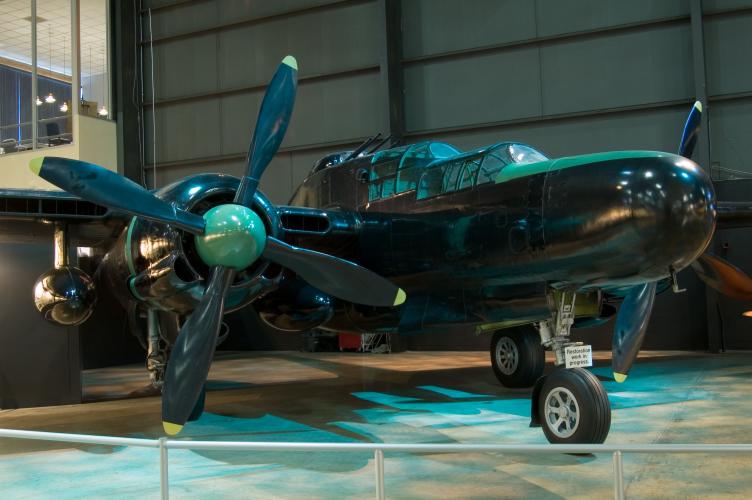
Armed with a deadly combination of four 20mm cannons and four .50 cal. machine guns, the Black Widow's arrival on the front lines was eagerly awaited. Production hurdles, including supply issues for the top turret, delayed its deployment, but by October 1943, the first P-61s were rolling off the line, quickly transitioning from defensive roles to aggressive night intruders after their arrival in Europe in March 1944.

As the war raged on, the Black Widow claimed its first aerial victory on June 30, 1944, when a P-61 named "Moon Happy" downed a Mitsubishi G4M Betty bomber over Saipan. It wasn't long before the Black Widow's presence dominated the night skies, amassing 127 confirmed aerial victories across the European, Mediterranean, Pacific, and China-Burma-India theaters.
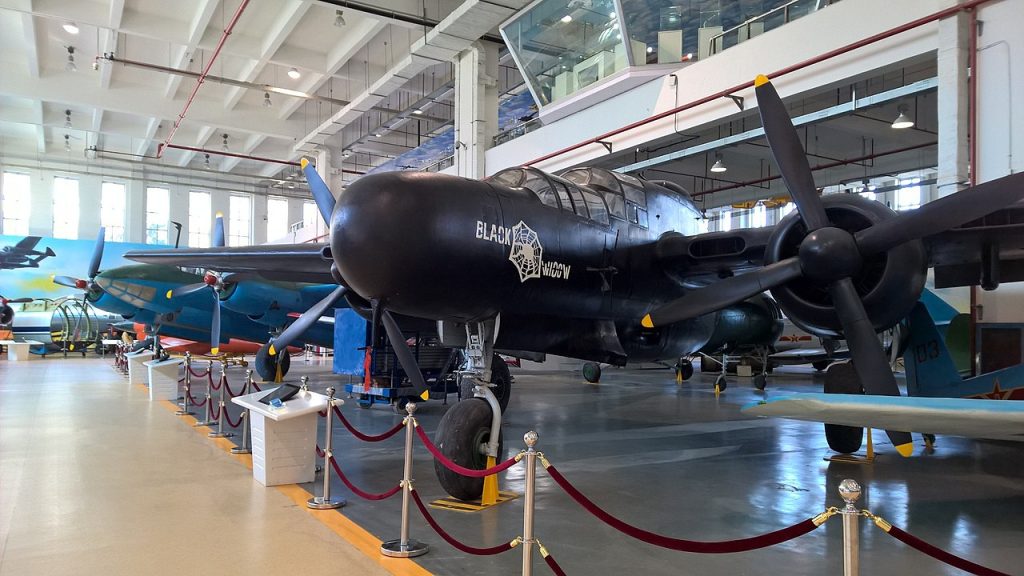
One particular P-61, dubbed "Lady in the Dark," became legendary for forcing a Japanese Ki-43 OSCAR into fatal crashes, without firing a single shot. The first incident occurred on the night of August 14-15, in the uncertain hours following Japan's surrender.
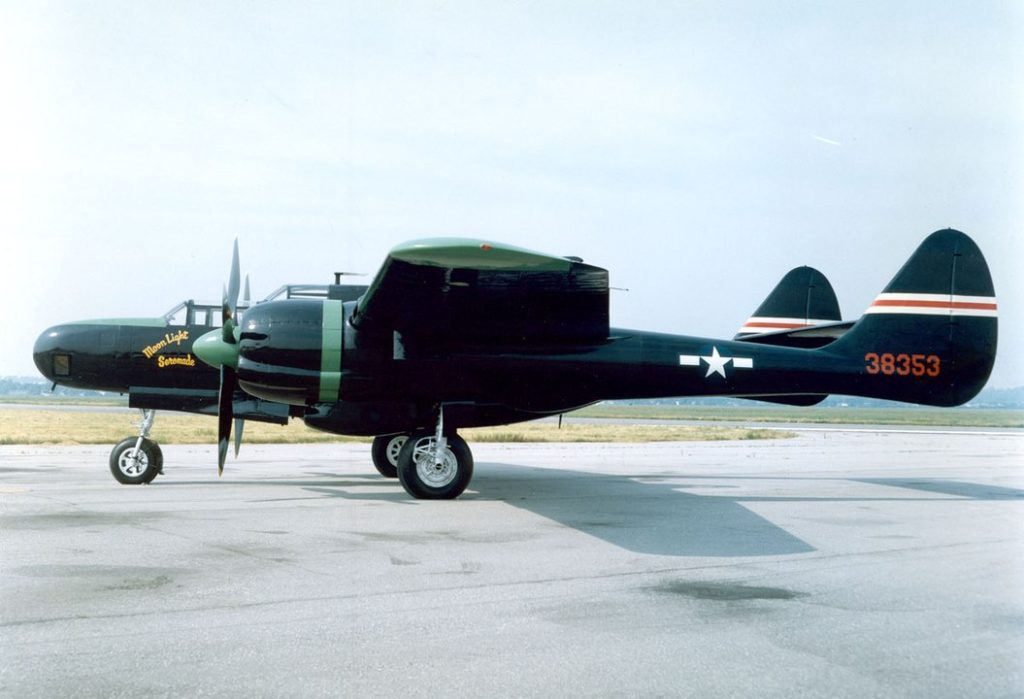
As peace returned, the P-61's role evolved. The cancellation of further production led to the Black Widow's adaptation for reconnaissance and scientific tasks. A variant, the F-15A, excelled in photographic surveys, while select P-61Cs contributed to meteorological research as part of the Thunderstorm Project.
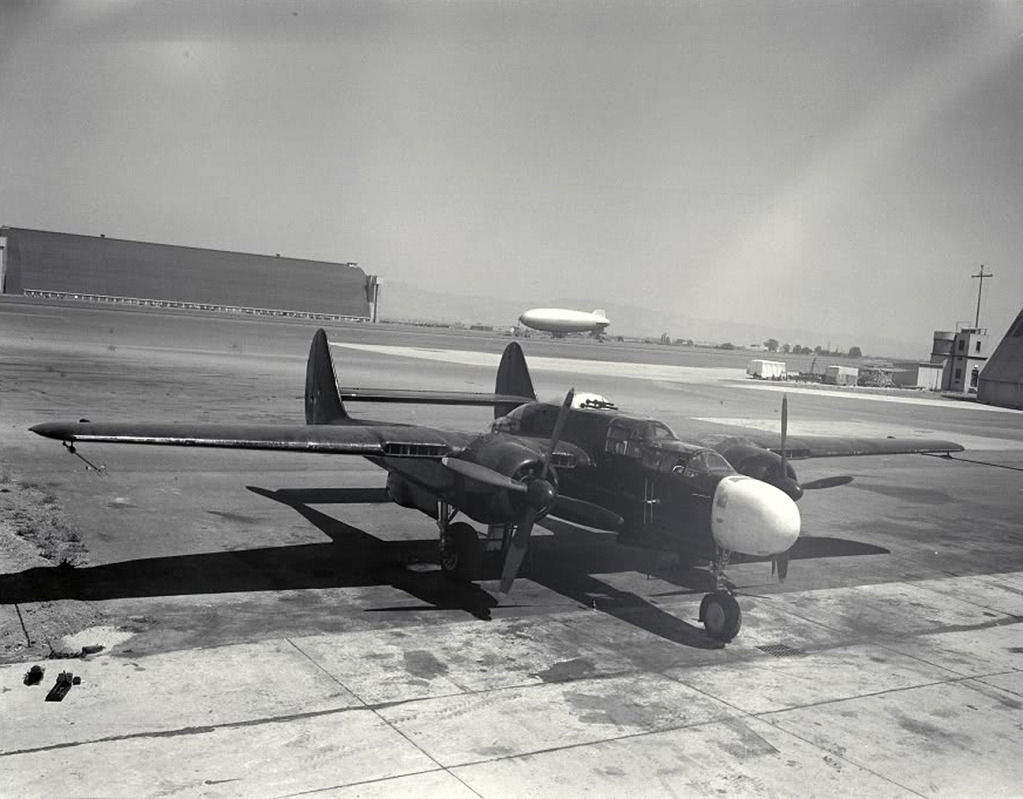
Ultimately, the end of WWII ushered in the twilight of the P-61's military service, with many transitioning to the Air Force surplus by 1950. Yet, even in retirement, the Black Widow's legacy endured through the National Advisory Committee for Aeronautics (NACA), which utilized the aircraft for high-altitude aerodynamic research until 1954.
related images you might be interested.

More for You
Tips And Tricks Even Seasoned ALDI Shoppers Might Not Know
4-Time Super Bowl Champ Files for Bankruptcy as Government Sues Him for Alleged $15.5 Million in Unpaid Taxes
Face of 75,000-year-old Neanderthal woman revealed
‘We got it wrong:’ WeightWatchers CEO on weight loss
Here's No. 1 thing mentally strong couples 'never' do, says relationship therapist of 20 years
Scientists say they have found a chapter of the Bible hidden under a section of text for more than a thousand years
Jeff Bezos Overtakes Elon Musk As Second Wealthiest Person In The World
Over 100 Russian Soldiers Reported Dead in ATACMS Strike on Firing Range
'10-foot-tall people' discovered by archaeologists in Nevada cave
Employers Are Avoiding Hiring Gen Z Workers- Here's Why
Peloton, the fallen fitness unicorn, faces a harsh truth despite its shiny new deal with Hyatt hotels: ‘I don’t think they thought [about] what was going to happen post-pandemic’
How much protein do you need to build muscle?
The first interracial kiss aired on TV more than 55 years ago—and more shows that broke racial barriers
What Actually Happened To 15 People We Made Movies About
Russia's Behavior on NATO Territory Sparks Warning
62-year-old started her business with $1,000—now it brings in over $25 million a year: 'I just had to do this'
Jamie Raskin Names And Shames The 'Evil Fairy' Secretly Setting 'The Country Back'
Six easy ways to lose an inch from your waist – in a week
GOP hard-liners use rare procedural move to block leadership-backed bill
What Happens to Your Body When You Eat Peanut Butter Regularly
Books | The Iron Sheik threatened to kill him. Years…
Share this:.
- Click to share on Facebook (Opens in new window)
- Click to share on Twitter (Opens in new window)
- Click to share on Reddit (Opens in new window)
- Click to print (Opens in new window)
- Food & Drink
- Amusement Parks
- Home & Garden
Things To Do
Books | the iron sheik threatened to kill him. years later, a road trip would reunite them., brad balukjian, a writer and academic who'd idolized the wwf wrestling star, writes about reconnecting with the legends of his youth in 'the six pack: on the road to wrestlemania.'.

Brad Balukjian, a gangly, socially awkward elementary schooler, loved the Iron Sheik, a villainous character known to wave an Ayatollah Khomeini flag while screaming “Death to America” at matches. So in 2005, Balukjian was set to become the official biographer of his Iranian idol – whose given name was Hossein Khosrow Ali Vaziri, or “Khos” for short – until the project, in spectacular fashion, melted down. (This wasn’t what’s known in wrestling as kayfabe – the term for pro wrestling’s blending of real/fake culture – either; the breakdown between hero and fan was a real one).
Balukjian went on to get a Ph.D. in entomology and became a science writer and a professor of natural history and sustainability at Merritt College in Oakland, but he never fully gave up on turning his Iron Sheik material into something.
So he did. Coming out of peak Omicron, Balukjian set out on a 12,525-mile journey to meet up with a handful of wrestlers who appeared at MSG that night like “Mr. USA” Tony Atlas , The Masked Superstar , Tito Santana , and the man who would claim the belt from Iron Sheik a month later, Hulk Hogan . The author would even reconnect with the Sheik himself .
Balukjian’s new work “The Six Pack: On the Road to Wrestlemania” is a spiritual sequel to 2020’s surprise hit “The Wax Pack,” in which he opened a pack of baseball cards from 1986 and went in search of what the players were doing now. For this book, Balukjian spent 62 days on the road seeking out his heroes from the WWF (now known as the WWE). The conversation has been edited for length and clarity.
Q: “The Wax Pack” was such an ingenious way to frame a book that I’m curious if you knew you wanted to tell “The Six Pack” in a similar fashion?
The best answer is, sort of? “The Wax Pack” was rejected 38 times and it took years to get published. People in the industry didn’t get what I was trying to do, which is take readers along on a personal quest, part sports history, part present-day reporting, part memoir, and not just a straightforward biography of baseball players or wrestlers. Once the book got out there and sold pretty well, I knew I had some leverage, but I didn’t want to write a straight sequel where I, say, open a pack of 1991 hockey cards or whatever. Even though it would’ve been fun and an easier book deal to secure, I wanted to push myself creatively but recognized that if I could somehow link the books thematically it could become my personal stamp.
I have a background in science writing, and an inspiration is Mary Roach , who’s created a cottage industry of books with one-word titles, “Stiff,” “Bonk,” “Gulp,” etc. Using the word “Pack” twice as part of the framework was a conscious choice, but “Six Pack” works in the WWF world for: The number of guys I caught up with from that 1983 lineup; the many, many beers they drank; and their ripped ab muscles. I’ve done some interviews with the WWE world where I’ve gotten a little pushback for putting myself in the book – some fans just want the war stories – but I think it’s a much more interesting approach. So the two books definitely have that road trip in common.

Q: “The Six Pack” also grew out of a book project with your WWF hero, The Iron Sheik, which you abandoned some 20 years ago because, as you write, he threatened to murder you?
That is the absolutely true story that serves as the “The Six Pack” prologue. He was my favorite wrestler when I was a young 1980s kid, and in 2005, I took a gamble and left a job as a magazine fact-checker in California, moving to suburban Atlanta to write a biography with him. We set off on this path together but the whole thing went sideways because he was too addled by substance abuse. On one occasion, I drove Khos to his crack dealer, so needless to say, the collaboration didn’t work out as I envisioned.
Q: And then Khos threatened to kill you by dealer’s choice: gun, knife, or broken leg? You went with the “.38 Magnum for my fate,” as it’s the quickest option, but I think a snapped femur would have a higher chance of survival, no?
Fair point, but I wasn’t thinking too clearly at that moment. To be honest, Khos was in his 60s and had the threat lingered and become truly menacing, I would’ve bolted and run away as fast as I could.
Q: The Iron Sheik isn’t the only character in the book with a host of problems. Was it surprising how far down stars like Tony Atlas had spiraled? You write that Atlas was basically living on the street due to severe drug addiction because as you declare in the book, “The Road ate people alive…”
There’s a show and podcast beloved by wrestling fans called the “Dark Side of the Ring,” which details what so many of these guys went through with drugs, sex, violence, steroids, and burning through money with no real health benefits.
What I try to add to the mix in “The Six Pack” is a way of looking at these aging men and how they view their lives now, their vulnerabilities and emotions as they look back. These stories hit on real-life issues we all deal with, fathers and sons come up repeatedly, so it’s as much a reflection on the humanity behind the kayfabe as it is ‘Wild Tales of the WWF.’
Q: As an interviewer, even after all these years, was it hard to portray them, or even just talk to them about their careers, as both human beings and their characters simultaneously? The all-encompassing 24/7 role is its own animal…
Professional wrestling is a totally unique art form and profession. When they sign an autograph, they sign their character name. Actors and musicians don’t do that, they might change their name for professional reasons, but it’s not a character. If you go to a convention today and wait in line to meet Sgt. Slaughter , that’s the name he’s signing, not Bob Remus. These guys inhabited these characters for the majority of their lives.
The whole point of “The Six Pack” is digging into to what extent did they actually become their characters? And once they were done wrestling, could they go back to their real selves? How does that work? So yes, when interviewing them it’s a Jekyll and Hyde dance you’re doing, trying to figure out the line between the man and the alter ego.
Q: You and the Iron Sheik ended on good terms before he died last June , was that the full circle of life piece you needed for “The Six Pack?”
Meeting up with Khos gives the book a driving narrative tension. What’s it going to be like seeing the man who threatened to kill me 17 years later? I knew he’d cleaned up, quit cocaine, and in working on the book, I had filled in all these gaps – like finding the now-94-year-old wrestling coach who welcomed Khos to the U.S. in 1969 – so I knew we had plenty of ground to cover. Over the years, I called him here and there, so there was some contact but I didn’t go see him in person until 2022. We spent a wonderful evening together, dinner with his family, and catching up.
He died less than a year later and the family invited me to attend his services. The Iron Sheik and I had a long history together. It was quite a journey from where it started to where it ended, but it marks a new beginning for me. The experiences I had in writing and reporting these two books has convinced me to leave academia and give full-time writing a go. There are plenty of old-school sports stories to be told. Pro wrestling will certainly be a part of it, the WWF left quite an imprint on my babyface childhood.
- Newsroom Guidelines
- Report an Error
More in Books

Books | This week’s bestsellers at Southern California’s independent bookstores

Books | How a French Ph.D. dissertation became a Southern California beach read

Books | 10 Independent Bookstore Day tips to find books, authors and giveaways

Lucas Lynggaard Tønnesen, Clara Rugaard, Til Schweiger Lead WWII Thriller ‘Desperate Journey,’ Written by ‘Il Postino’ Director Michael Radford (EXCLUSIVE)
By Alex Ritman
Alex Ritman
- Kevin Spacey Fires Back at New Doc About Alleged Abuse: ‘I Will Not Sit Back and Be Attacked’ by a ‘Desperate Attempt for Ratings’ 9 hours ago
- Kerry Condon, William H. Macy, Clifton Collins Jr. Join Black Bear’s Denis Johnson Adaptation ‘Train Dreams’ (EXCLUSIVE) 10 hours ago
- Kristen Stewart, Oscar Isaac Teaming for Hedonistic ’80s Vampire Thriller ‘Flesh of the Gods’ From ‘Mandy’ Director Panos Cosmatos 11 hours ago

Lucas Lynggaard Tønnesen (“1899, “Borgen”), Clara Rugaard (“Verona,” “I Am Mother”) and Til Schweiger (“The Ministry of Ungentlemanly Warfare,” “Inglourious Basterds”) lead the international cast of “Desperate Journey,” a newly-announced thriller set in the burlesque world of 1940s Paris.
The film — which has now wrapped production — comes from Emblem Pictures, and was written by two-time Oscar nominee Michael Radford (best known for directing 1994 global sensation “Il Postino”) and directed by Emmy winner Annabel Jankel (“Tell It to the Bees”).
Popular on Variety
“It was a tremendous journey of personal growth for me, working with the extraordinarily talented and creative cast and crew in Budapest,” Jankel said. “Lucas Lynggaard Tønnesen excited us daily with his performance as he grew into and fully embodied the unique character that was Freddie Knoller.”
Added producer Derosa: “Freddie faced extreme situations and emerged with an understanding of life that could benefit us all. He was an exceptional man, and I am deeply grateful to the large crew and cast who worked tirelessly to portray this remarkable story.”
“Desperate Journey” is the first of three planned productions from Emblem Pictures.
More From Our Brands
Mariah the scientist arrested after alleged altercation in atlanta club, meet the ferrari 12cilindri, the new 819 hp gt with a roaring v-12, jessi miley-dyer named world surf league commissioner, be tough on dirt but gentle on your body with the best soaps for sensitive skin, ghosts bosses talk finale’s wedding twist, isaac cliffhanger and pete’s power limitation — plus, grade it, verify it's you, please log in.

IMAGES
VIDEO
COMMENTS
The Long Road to America - One Refugee's Experience. Refugees lining up with their suitcases - all their worldly possessions - as they get ready to board a plane for their new homes in the U.S. The journey to migrate to the United States can be a long hard road for most refugees and immigrants. Each year, close to 50,000 refugees and ...
A single mother of adult children, Lucia operated a small eatery in her house on the neighborhood's main street, where she sold eggs, plantains, and fried beans for seven years. Every month, she ...
Of the 77 vessels which left Liverpool for New York between 1st August and 31st October, 1853, 46 contained passengers that died of cholera on the journey. The Washington suffered 100 deaths and the Winchester lost 79. All told, 1,328 emigrants died on board these ships on the way to America. The most common killer was typhus.
By Fiscal Year 2014, the number of Central American migrants surpassed those from Mexico for the first time in history. Still, migration to the U.S.-Mexico border is constantly evolving .
Before the mid-1800s, the journey to America was long and difficult. Immigrants first travelled by foot or cart to a nearby port where they arranged and then waited for a sailing ship to take them to America. Poor immigrants travelled to America on ships that were making their return voyage after having carried tobacco or cotton to Europe.
Grantee. This is the story of the exceptional journey of extra-continental migrants—from places as far and disparate as Cameroon, Iran, and Bangladesh—on one of the most circuitous routes to reach the United States via South and Central America. Their routes converge in one of the most hostile and isolated tracts of land on the globe: a ...
From Native Americans who migrated across a land bridge to North America to immigrants who sailed aboard a steamship to Ellis Island, many chose to come to America. Hundreds of thousands of others were brought here against their will aboard slave ships. Throughout this history, we have debated who should be allowed to come to live here and who ...
For many European immigrants to America, the transatlantic crossing was just part of a long journey. First, they had to travel to their point of departure. The passenger lists on Ancestry show that many traveled hundreds of miles before they ever set foot on a ship. Immigrants crowded into rail cars or local boats to get to the port, such as ...
The State of the American Dream Editor's Note by Brittney Bain, Editor of The Catalyst; Keeping the American Dream Alive A Conversation with former Speaker of the House Paul Ryan; Transforming Lives and Creating Opportunity for At-Risk Youth A Conversation with Chad Houser, Founder, CEO, and Executive Chef at Café Momentum; Grit and Community are Key to Reaching Full Potential An Essay by ...
Simon Worrall. On an autumn night in 1607, a furtive group of men, women and children set off in a relay of small boats from the English village of Scrooby, in pursuit of the immigrant's oldest ...
Short film drama, based on true life/events. Janek and his family immigrated from Poland to America. Family stopped in Ellis Island, NY to be check out throu...
The day the historic journey to America began. It is one of the most well known dates in history - on 16 September 1620, a group of men, women and children departed Plymouth aboard the Mayflower for a new life in America. But for many of its influential passengers the historic voyage actually began several weeks before - on July 22, 1620, from ...
The journey to America was a long and harsh one. After days at sea, most immigrants landed at the infamous Ellis Island. As they walked into the cavernous dark halls, fearful and anxious, they were "greeted" by immigration officials shouting orders.
The explorer Christopher Columbus made four voyages across the Atlantic Ocean from Spain: in 1492, 1493, 1498 and 1502. His most famous was his first voyage, commanding the ships the Nina, the ...
After departing England in 1608, the Pilgrims found sanctuary in the Dutch city of Leiden, where they were free to worship and enjoyed "much peace and liberty," according to Pilgrim Edward ...
Millions of people made the long journey to America in the early 1900s. They looked for freedom, safety, or the promise of a new life. Follow the waves of immigrants that flooded into the United States to see why they came and how they changed the country. Meets Common Core standards for...
The Long Journey to the Americas Era 1 - 4a. Click the Button for Worksheet: 4a.pdf: File Size: 361 kb: File Type: pdf: Download File. Powered by Create your own unique website with customizable templates.
The journey to America was often arduous and hazardous. Most immigrants undertook long and treacherous voyages lasting several weeks on overcrowded ships, commonly referred to as "coffin ships." Conditions onboard were typically unsanitary, with limited food and medical care. Many passengers did not survive the journey due to disease and ...
©1998 - Public Broadcasting Service
Well-maintained ships with experienced crews completed the journey more quickly. During the 1600s, the average duration of the journey from England to America was around 8 to 12 weeks, varying depending on these factors. These voyages were challenging and perilous, with many hardships faced by the crew and passengers.
Patrick Long. 18 reviews 1 follower. July 13, 2021. ... Journey to America is an adventurous, breathtaking, intense, novel. This book is recommended for boys and girls from ages 10-13. It is al little bit about the holocaust so knowing about the Holocaust will come in handy. This book is a fantastic book that will keep the reader on their toes.
Ben and Carlos talk about the new draft rankings at Baseball America and briefly touch on the state of the class and how the group… April 25, 2024 April 25, 2024 Show All Podcasts
Wong earned her first starring role at the age of 17, portraying the doomed Chinese lover of an American man in the early Technicolor film The Toll of the Sea (1922), a loose adaptation of the Madame Butterfly story. She won accolades for her natural acting talent and stage presence, and she began landing roles in more prominent films, including The Thief of Bagdad (1924) starring action ...
Pilgrims boarding the Mayflower for their voyage to America. The Pilgrim's arduous journey to the New World technically began on July 22, 1620, when a large group of colonists boarded a ship ...
Back to Black: Directed by Sam Taylor-Johnson. With Marisa Abela, Jack O'Connell, Eddie Marsan, Lesley Manville. The life and music of Amy Winehouse, through the journey of adolescence to adulthood and the creation of one of the best-selling albums of our time.
The overwhelming bipartisan vote for the long-stalled $95.3 billion aid package capped a tortured journey for the legislation on Capitol Hill. President Biden is expected to quickly sign it.
The new Carnival Firenze cruise ship, embodying Italian elegance, arrived at Long Beach, California, on April 23 to start its new journey as part of Carnival's American-based fleet.
It wasn't long before the Black Widow's presence dominated the night skies, amassing 127 confirmed aerial victories across the European, Mediterranean, Pacific, and China-Burma-India theaters.
Coming out of peak Omicron, Balukjian set out on a 12,525-mile journey to meet up with a handful of wrestlers who appeared at MSG that night like "Mr. USA" Tony Atlas, The Masked Superstar ...
Lucas Lynggaard Tønnesen, Clara Rugaard and Til Schweiger lead 'Desperate Journey,' written by 'Il Postino's' Michael Radford.